The 10 types of posts and how to use them
How to talk about the same topic in 10 different ways.
If you create content, then you’ll want to bookmark this post.
This post methodically details the 10 fundamental types of posts you can create. It tells you what they are, what they’re good for, and how to do them (including step-by-step frameworks).
Knowing the types of posts and how to use them can drastically improve the quality of your posts and the outcome you get from them.
All while making it easier to create them.
We’ll dive deep into these 10 types of posts:
If you’ve read Justin Welsh, he details 8 different post types. Based on my research, I have changed and expanded them.
Let’s dive in.
But first, here’s a tl;dr cheatsheet
Reference this later as you write. Here’s a high-res version.
1. Actionable
A step-by-step breakdown of how to do something.
Actionable posts are often “How to X” or “How I X.”
Generally, you want somebody to feel equipped and able to implement your advice without feeling confused or stuck. They should just be able to take your advice and get to work.
Actionable posts demonstrate your expertise.
They also make people like and appreciate you for helping solve their problems.
And when they run into trouble implementing your advice (because things are hard), they’ll come to you for help. So, they’re particularly effective for coaches, consultants, freelancers, and agency operators.
Actionable posts are typically done in Threads, Carousels, or long-form text or video. But you can also do a short form one like this:
This glosses over a ton of nuance and steps, but these are the steps you’d need to follow to create the type of business Jon has. Each one of those steps could be its own post.
Let’s dive into some longer-form examples.
Examples
How to build a $300/day side business – Jon Brosio
How to make an extra $2500/mo selling ebooks – Jon Brosio
Actionable content is extremely powerful at demonstrating your expertise and building affinity with your audience.
Our agency, Bell Curve, got nearly all its leads from a single mega-piece of content that my cofounder wrote on “How to Acquire More Users.”
This one piece of content allowed us to work with clients like Microsoft, Figma, Lamba Labs, Huobi, Cameo, and Envoy in the first two years.
It was an 80/20 run-through of startup growth with step-by-step advice on writing a landing page, creating and running ads, doing content marketing, improving onboarding, B2B sales, and A/B testing.
People would go through it and see how hard growth was.
Because someone had methodically taught them how to do it, they trusted Julian (and our agency) to do it for them.
Note: This guide has since been broken into two pieces: the Growth Guide on Demand Curve’s website and Julian’s Startup Guide.
How to do Actionable posts
List everything your customers need to do to achieve their goals. For example, someone starting a personal audience will need to:
Pick a topic/niche
Pick a channel
Pick a content style
Learn how to write good content (huge topic with tons of subtopics)
Get over imposter syndrome
Get in the habit of posting and engaging
Engage with other creators
Create a system for generating ideas and getting inspiration
Figure out which problems are the most painful or the ones people ask the most about directly to you or on Reddit/social.
Write a step-by-step guide to solving that problem. Try to make it the only resource they’ll need to solve it. You can do this by either:
Writing purely based on your expertise.
Doing a bunch of research (books, articles, podcasts).
Interviewing experts and compiling their advice. This is Lenny Rachitsky’s model for his newsletter (the largest and most successful Substack).
Done right, actionable posts are some of the most powerful for generating leads.
2. Observation
What have you observed in your industry that others aren’t talking about?
The point of these posts is to:
Show people how you think about the world.
Demonstrate your thought leadership.
Make people think differently.
To attract your tribe to you. More on this in the Contrarian section.
They’re often short-form but don’t have to be if there’s much to be said on the topic (I’ll give some examples below).
They’re typically text only or text + image. A carousel is overkill.
Examples
Short-form examples
Long-form examples
Notice they’re articles. However, these could technically be carousels as well, especially if you have a lot of images.
How to do it:
There are a few ways.
#1. The brute force way:
Turn on focus mode and close other tabs.
Set a timer for 30 minutes.
Jot down as many short-form ideas as you can. This is the brainstorming phase.
Then, filter the ideas for the great ones and edit them to make them punchier.
Repeat regularly. The best ideas will take a while to come out.
#2. The ad hoc way: if an idea hits you randomly, jot it down.
#3. The research way: browse other people’s social accounts and find observations they’ve made. Put your unique spin and perspective on them, or use that to inspire your unique observations.
If they don’t work the first time, rewrite them and try again.
If they do well in short-form, consider expanding further in long-form.
3. X vs. Y
Compare two things, situations, or states of being with an interesting takeaway.
X vs Y posts are effective at highlighting your values and encouraging discussion. And for making a point.
They can be a quick comparison or a methodical breakdown in a carousel or thread.
One reason they’re so effective is the cognitive bias of “What you see is all there is,” where people tend to evaluate the information that’s currently presented rather than tapping into all the knowledge they have about the world.
The X vs. Y comparison causes them to tunnel vision on how you present it, allowing you to control how they perceive the “bad alternative” and the “good alternative.” Usually, the good alternative represents the thing you sell.
Examples
Short-form:
Longer-form:
Can see Rob’s post below here.
How to do it
Choose two things to compare and either do it in a sentence or two or bullet point it out. Ideas of things you can compare:
What happens when you do X vs. what happens when you do Y (or don’t do X)
Before vs. after
Past vs. Present or Present vs. Future (how will technology and future trends change things in the future)
What I want vs. what I don’t want
What people want vs. what they get
What people think vs. reality
Group A vs. Group B
There are endless ways to do this. Use the above examples to get started.
Note: If you follow Justin Welsh, he breaks Present / Future out as a separate type of content, but I think it’s a subset of X vs Y or observation.
Bonus points if you convert the text into a nice, eye-catching visual.
4. Motivation
Sad truth: Most people don’t need to learn more to achieve their goals.
Instead, they need motivation and encouragement to take action.
This is why the self-help industry is so big.
The key is to motivate your audience to achieve their goals while triggering their Fear of Being Outdone and highlighting your credibility.
These posts are typically shorter-form unless it’s done in a video and you’re Tony Robins doing a long speech.
Examples
This post from Justin Welsh is well executed:
It’s visually appealing. The list with times gets your attention).
It leaves you hanging and forces you to click to learn what the catches are.
It also makes you stop and re-evaluate your life.
“Wtf, I wish my day looked like. And wait, doesn’t he make 7-figures per year???”
It triggers your Fear of Being Outdone while also making Justin seem credible, preaching that we should all become solopreneurs. And it motivates you to work towards the dream that Justin is selling.
Here are a couple of others from Lara Acosta that do the same:
Here’s another simple motivational post that’s more blatantly motivational:
How to do it
Here are two broad steps:
Identify your customers’ selfish desires. What do they want deep down that they might not be willing to admit? This usually comes down to status, wealth, and power.
Find ways to encourage your audience that achieving their selfish desire is possible and is everything they want. This often boils down to:
Making it sound easier. Example: Jon Brosio’s post above illustrates that generating content ideas is easier than you think. Even oversimplifying could help someone get over the fear of starting.
“I did it; you can too.” Make yourself seem unprivileged and relatable, then share how you overcame the difficulties and achieved the success they’re striving for (personally or for others).
Highlight how awesome it is. Example: Justin Welsh sharing his enviable daily schedule or pictures of him hiking during work hours.
Sharing big wins. Like Lara being featured in Forbes. It’s a dream for many, and people want to celebrate her achievements.
5. Analytical
Teardown of a topic, company, person, content style, framework, etc.
For example, this post is an analytical one. It discusses “types of content” in depth.
Analytical posts go deep, so you need a carousel, thread, long-form video, email series, newsletter, article, or even a series of emails.
This one is my favorite.
Examples
How to do it
First, you need to identify things to analyze. Here are some ideas:
People (ex: Jeff Bezos’ advice, quotes, story, etc.)
Companies (how Apple grew to $1T)
Research (ex: how backlinks affect Google search rankings)
Trends (ex: how Mr Beast is influencing YouTube)
Ways to achieve something (how to write hooks, types of posts, copywriting frameworks, etc)
How people do things (analysis of LinkedIn’s top 30 creators’ hooks)
As you did for Actionable posts, you must identify everything your customers need to do to achieve their goals. Instead of explicitly telling them how to do something, with Analytical posts, you can analyze:
How Bezos did it
All the possible ways it could be done
How the way it’s done has changed
The effect of doing it
And so on.
6. Listicle
A list of things related to your industry, likely with minor commentary:
People to follow
Books to read
TED talks to watch
YouTube channels to watch
Podcasts to listen to
Tools/software to use
Products to buy
These have historically performed extremely well because they’re aggregated research for people. An easy bookmark and comment: “This is awesome, thanks!”
It also warrants a comment/engagement from the creator of those things, leading to increased post visibility.
But it’s also one of the most shallow types of posts.
You’re not teaching anything.
You’re not demonstrating any expertise.
You’re not making people think or inspiring them.
You’re just listing out some potentially useful stuff.
They also don’t tend to perform as well anymore, as algorithms have adjusted not to weigh these so heavily.
So, as Justin Welsh recommends, do these sparingly.
Usually done as a thread, text-only, or carousel.
Examples
^ The “curated” style like the one above still does fairly well, IF you are good at curating images that give people dopamine hits and haven’t been seen before.
How to do it
Pick a category of things from this list:
People to follow
Books to read
TED talks to watch
YouTube channels to watch
Podcasts to listen to
Tools/software to use
Products to buy
And tailor it to your industry.
Add context to WHY each item is important for your audience to consider/use them to achieve their goals and selfish desires.
7. Contrarian / Trolling
Here you ruffle some feathers by making strong statements how things should be done, or how things are being done wrong.
Contrarian posts are great for:
Encouraging discussion. Strong opinions elicit strong reactions.
Attracting your tribe by saying what they wish they said.
Making them think.
If you give people an epiphany, they get a little surge of oxytocin (the bonding chemical), making them feel more connected to you.
There can be some overlap with Observation, but they differ because they:
Are strongly worded and spiky opinions
They sometimes aren’t observations but rather opinions or hard fact
They throw jabs at people, their actions, or their beliefs
Examples
They can be a bit hard-hitting and potentially ruffle feathers:
Or they can challenge an existing societal belief that won’t offend anybody:
And instead of just stating an opinion, you can demonstrate it by trolling:
How to do it
First, you must develop and identify your “spiky point of view” of the world.
What the hell is a spiky point of view? Well, here it is from Wes Kao herself:
Here’s the full article about spiky points of view if you’re interested.
Essentially, it boils down to:
What do you believe differently than many others in your niche?
How do you see the world differently than your peers?
How have your experiences influenced you?
For example, for me, here are unique aspects that shape how I view the world:
I lived out of a backpack for 3.5 years in my mid-20s, prioritizing life experiences over career and monetary achievement.
I’m a mechanical engineer turned programmer reluctantly turned marketer. I entered marketing believing ads were made to convince people to buy things they don’t need. As such, I’m skeptical of many marketing tactics and dislike inauthenticity.
I try to explain complex concepts in simple, easy-to-understand ways because I saw how badly engineers communicated complex ideas to non-engineers.
I bootstrapped my companies without connections, experience, or resources. We made money consulting and kept reinvesting it. We spotted opportunities along the way and put resources behind them. As such, I’m skeptical of the VC funding route.
We’ve grown our companies purely through organic content slowly nurturing people over time, rather than doing heavy ads or sales pushes. As a result, my opinions are shaped by what worked for me.
I’ve been told by various people that I should be a comedian and that I’m sarcastic and witty. I use that to my advantage on LinkedIn, where people are quite boring because it’s a very business/corporate/professional environment.
These life experiences and qualities shape how I view the world and use them to create content and build an audience.
Find yours and champion your views.
8. Testimonial / Client Win
Warning: This post type will generally NOT get you much engagement or followers.
But it is one of the best for actual conversions.
Nothing sells better than a happy customer or proof that your product works.
A single post I did on LinkedIn led to at least $30k in revenue. It shared the success stories of former students. It’s the first example below.
Examples
There are various ways to do this. Check the captions below.
How to do it
There are a few ways to do this, as hinted above:
Share a testimonial directly (quote image or video). Use the post's text to expand on what you did for them.
Share a win you had for the client (with permission).
Talk about their problem and how you helped them overcome it.
Create a longer-form case study.
Get them to post their story directly and then quote-tweet it.
Share a DM conversation with them to highlight their win.
Use their win as a hook to then share your general process/framework.
Then, ask people to DM to learn more. Or add a direct link. Or have a link on your profile and direct people there. Or put a link in the comments.
Note: Asking people to comment to show their interest is risky because that then makes it public how many people are interested. If you anticipate a lot of demand (like for a free lead magnet), it’s a good thing. If it’s possible there won’t be (like for paid consulting), then asking for a DM keeps it private and a mystery.
9. Personal Story
We all love a good story.
They deepen the connection people have with us.
Stories allow you to show, not just tell. People can see themselves in the story, feel the pain, and believe the solution.
A personal story is the number one post type that compels people to DM me and has been used to sell our course.
They can used to build a deeper connection, teach, or sell your product.
Examples
How to do it
First, you need to have a story to tell. It doesn’t have to be a crazy travel story. It can be a simple story about a totally normal problem you faced and overcame.
It’s actually better if the story is relatable.
Think back on your life and career. Jot down all your highs and lows. The failures and the achievements. Or stories that you find yourself repeating to friends or colleagues.
Then, you have to write them.
Storytelling is an art form, but here are some basic principles.
The Hero’s Journey
Surprisingly, a lot of movies and books have the same basic structure:
Eric Partaker (a former student with 600k+ followers now) used the Hero’s Journey as the framework for his carousels teaching leadership principles.
A 12-step framework might be a tough place to start, so I instead suggest the Pixar storytelling framework (that they’ve used in some of the best movies of all time):
Once upon a time, ___________________.
Every day, ___________________.
Until one day, ___________________.
Because of that, ___________________.
Because of that, ___________________.
Until finally, ___________________.
Fill in the blanks, and you have a story. Let’s illustrate this with an example:
Once upon a time, Alice, the founder of a creative agency, was on top of the world.
Every day, she'd do sales calls for inbound leads and crush her client work.
Until one day, a recession hit and cut inbound leads by 2/3rds.
Because of that, she needed to increase leads, or else she'd have to lay off staff.
Because of that, Alice started posting on LinkedIn and Twitter. Most of her posts flopped, but a few did well and brought in leads. However, she had a tough time running a business and consistently creating good content.
Until finally, she joined the UNIGNORABLE Challenge to learn how to create content that resonates with her audience systematically.
This framework allowed me to create a basic story with a proven structure about our course in a few minutes.
The shape of stories
There’s also this delightful video of Kurt Vonnegut teaching the shape of stories:
Use them to shape your story arc.
10. Meme
The meme is a special category.
It can dip its toes into several of the ones above. A meme can be contrarian, compare and contrast like X vs. Y, or make a humorous observation.
But the goal is to make people laugh and think and give them a quick dopamine hit that causes them to click, like, and share as a knee-jerk reaction.
The best memes reinforce your spiky point of view. They shouldn’t just be funny to anyone with thumbs; they should be funny to your specific audience and communicate your core ideas.
Examples
How to do it
There are three ways you can do it:
Hunt: Go through various subreddits (and Instagram accounts) and find posts that were either at the top or were good but didn’t take off due to a bad hook. Adapt those to your industry.
Gather: Follow social media accounts that share memes. When you find a good meme or meme format, adapt it to your industry or sharing it directly.
Farm: Use a meme generator site to explore the various formats. Go back and forth with a friend, making memes to make each other laugh. When you find a good one, you’ll both know it.
Have fun with it. If you’re not, they won’t.
And here’s meme master Aidan Brannigan’s playbook:
What’s next
Now that you know all the types of content, there are various next steps to creating content that grows your audience and converts readers into customers.
I plan to write thorough guides, like this one, for each of those steps and will add links as time goes on. But essentially, here there are:
Figure out some foundational things like:
What you’re writing about
The job to be done of your content
Who you’re writing it for (and the pains they’re experiencing)
Pick a channel (LinkedIn, TikTok) and content format (video, carousels, etc)
Revamp your profile.
Learn the 10 Ways to Hook People to get people to stop scrolling.
Improve your overall copywriting with these tips:
7 Copywriting Frameworks that Sell. Frameworks are helpful templates to ensure you hit all the necessary psychological biases.
10 Tips to Improve Your Copywriting. Write clear, concise, and crisp copy.
10 Literary Devices with Examples. Make your writing more interesting.
Create a newsletter or podcast to nurture followers.
Create lead magnets and funnels.
Engage and network. It’s called SOCIAL media for a reason.
Systematize your content creation
Build a content creation system
Create repeatable formats
Find sources of inspiration
Figure out the tools to use with the Audience Building Tool Stack
And much more.
Cheers folks!
If you like this post, share it with a friend trying to grow on LinkedIn or X!
How I can help you grow:
Growing a personal audience? Book a consultation call to get clarity.
Need to run ads? We’ve built the ads agency for startups.
Need to hire an agency/freelancer? We’ll match you with a vetted partner for $0.
😍
– Neal
PS: If you’re reading this, you are one of my favorite people, and you should DM me on LinkedIn or Twitter to say hi!





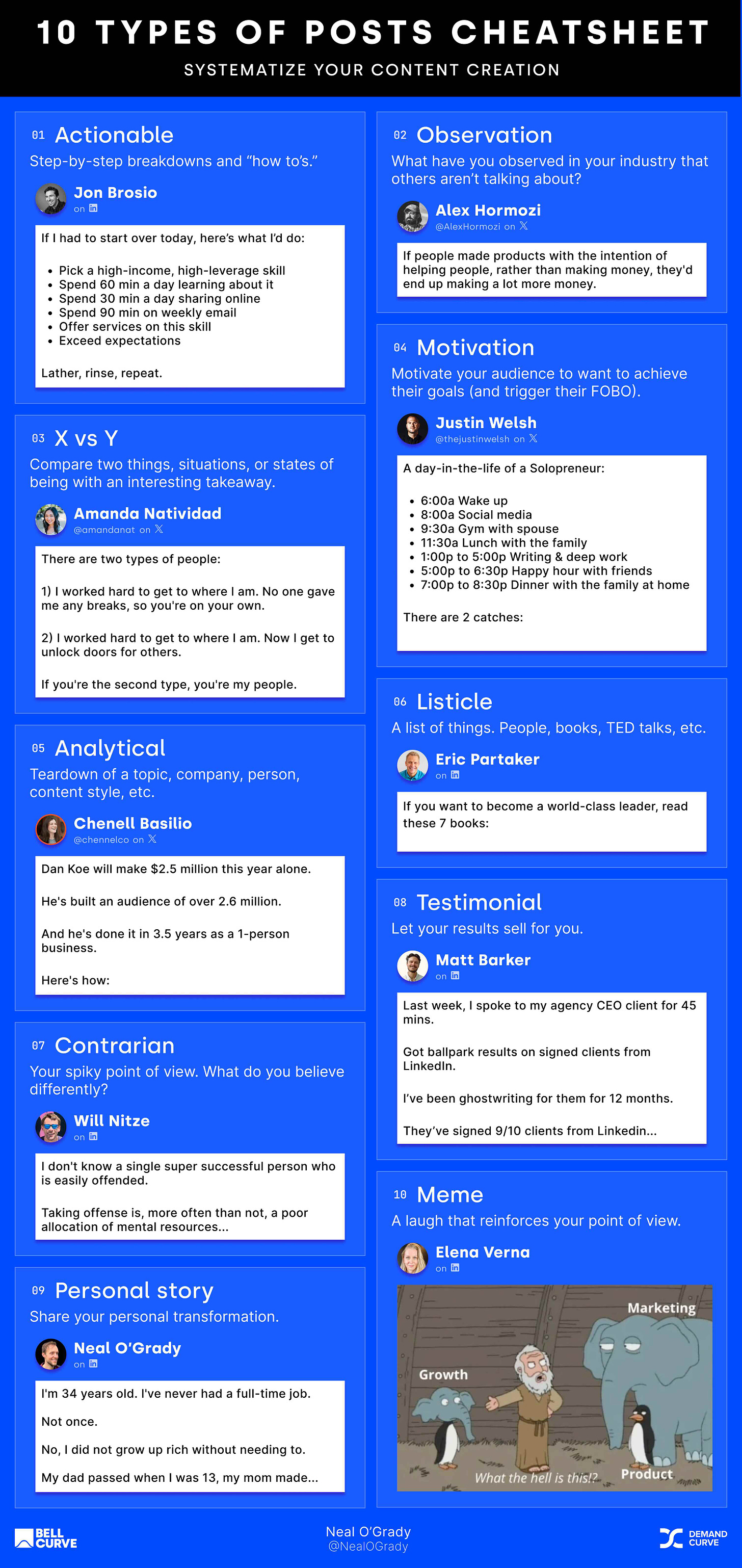
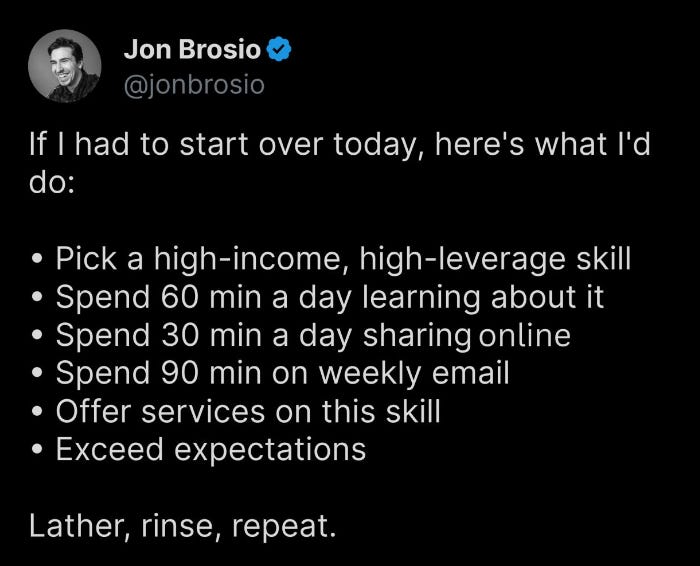

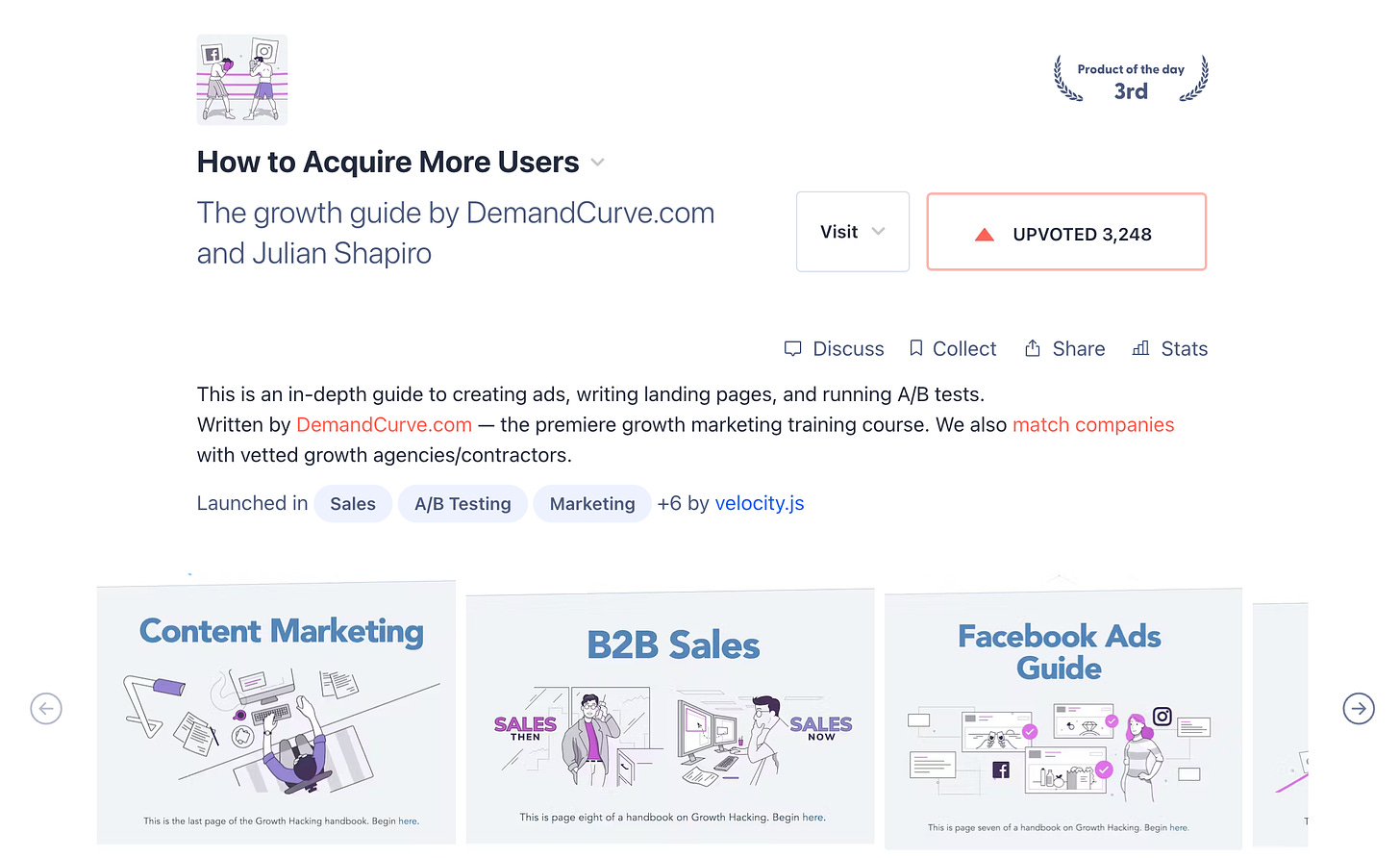
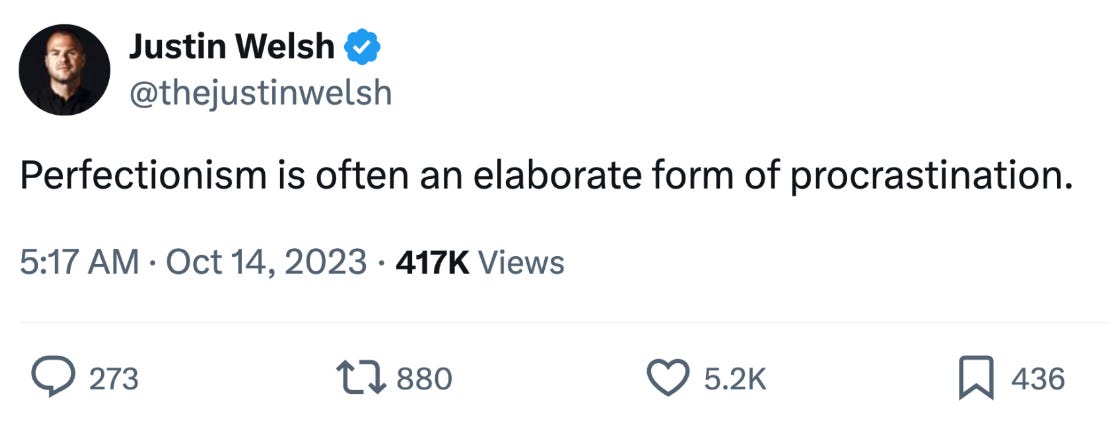
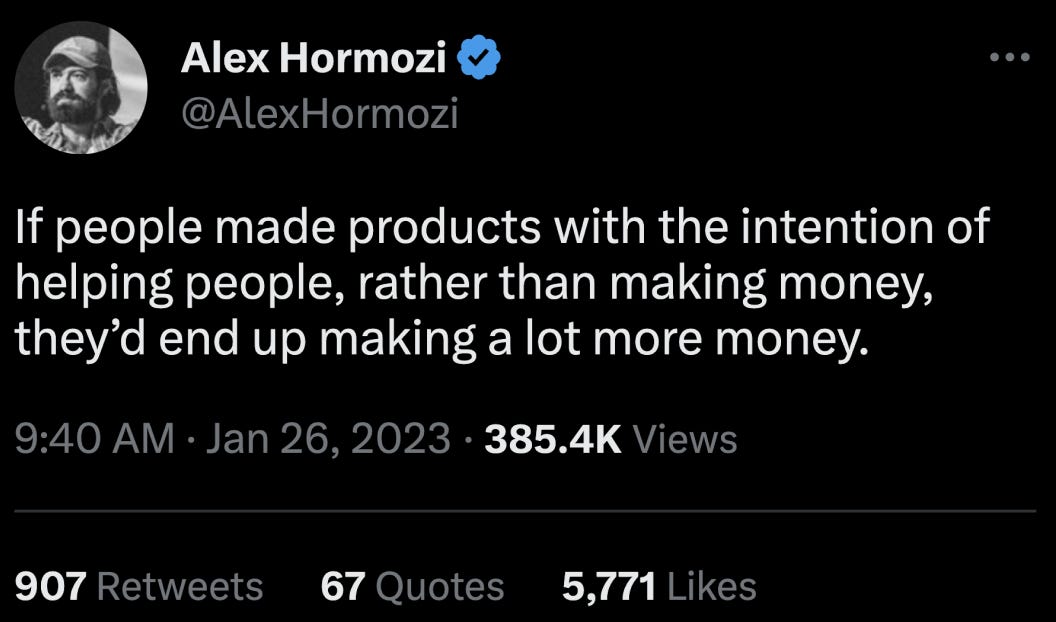
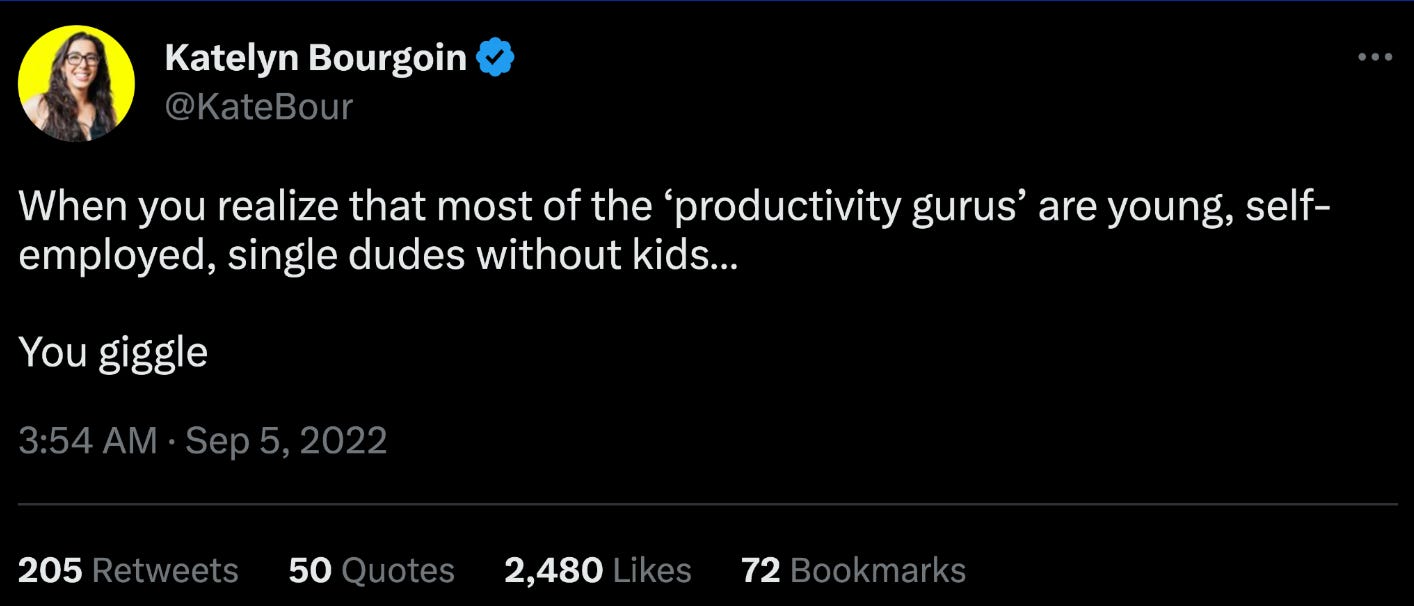
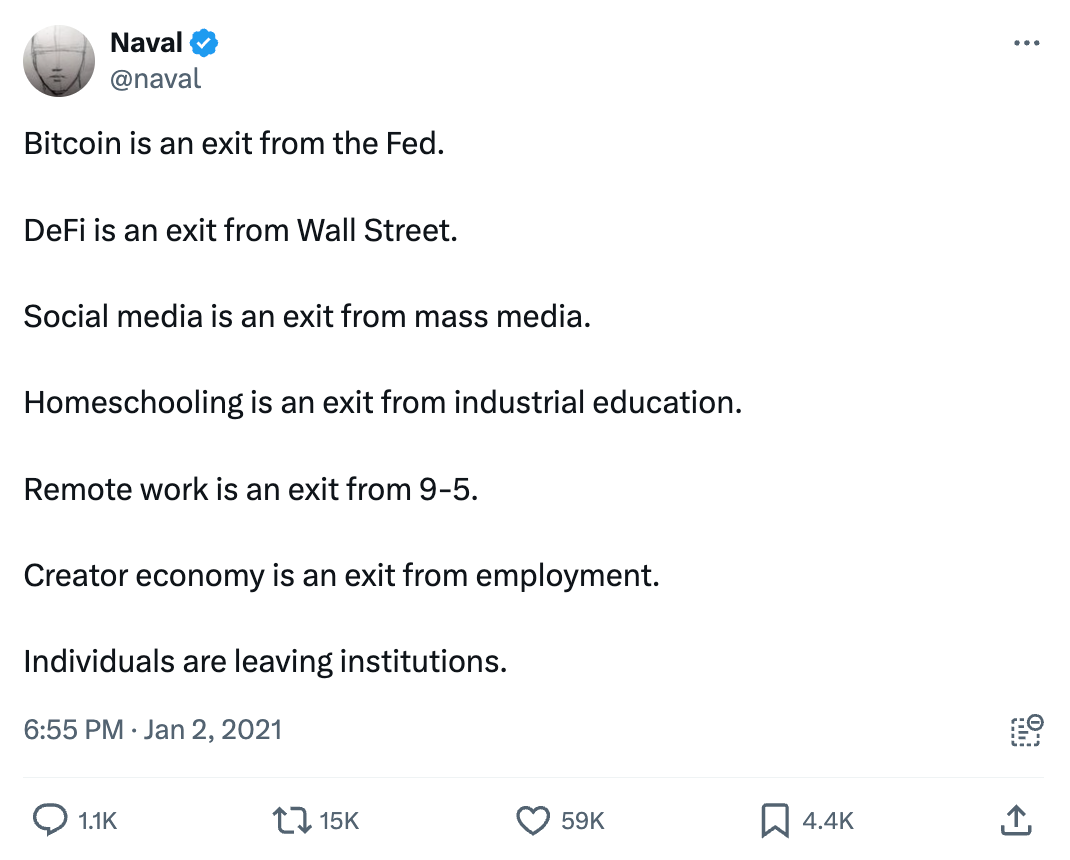



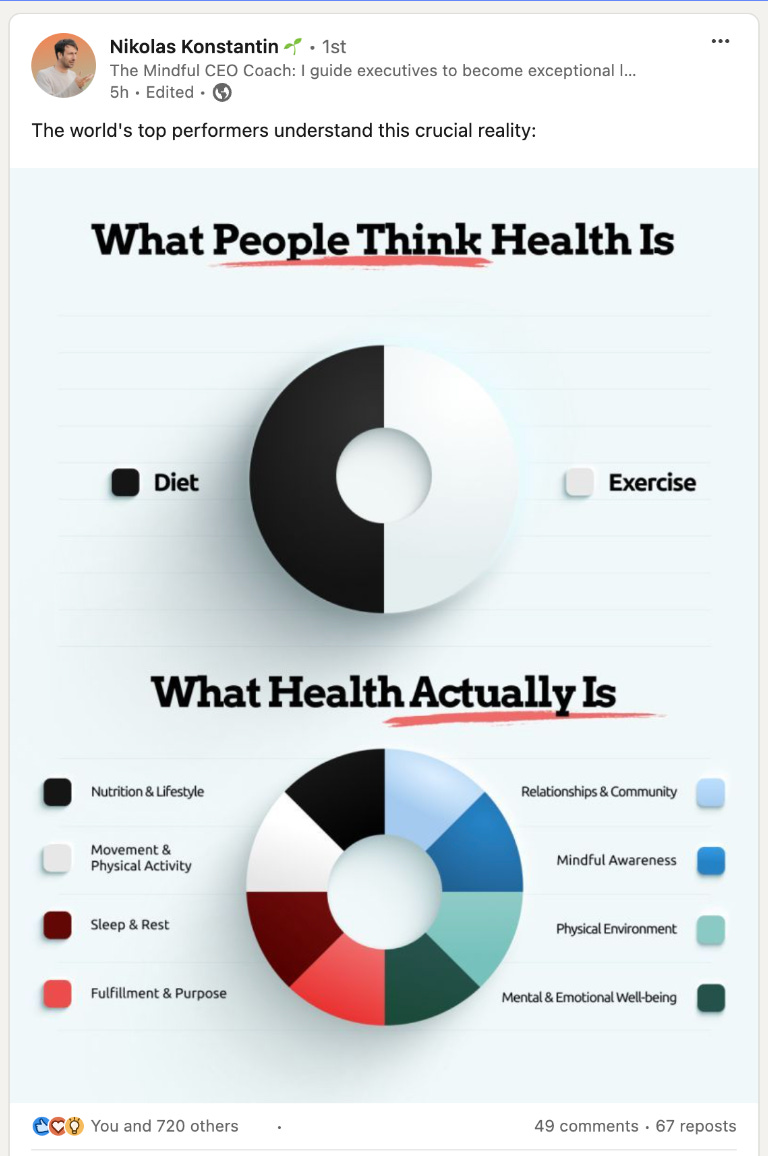
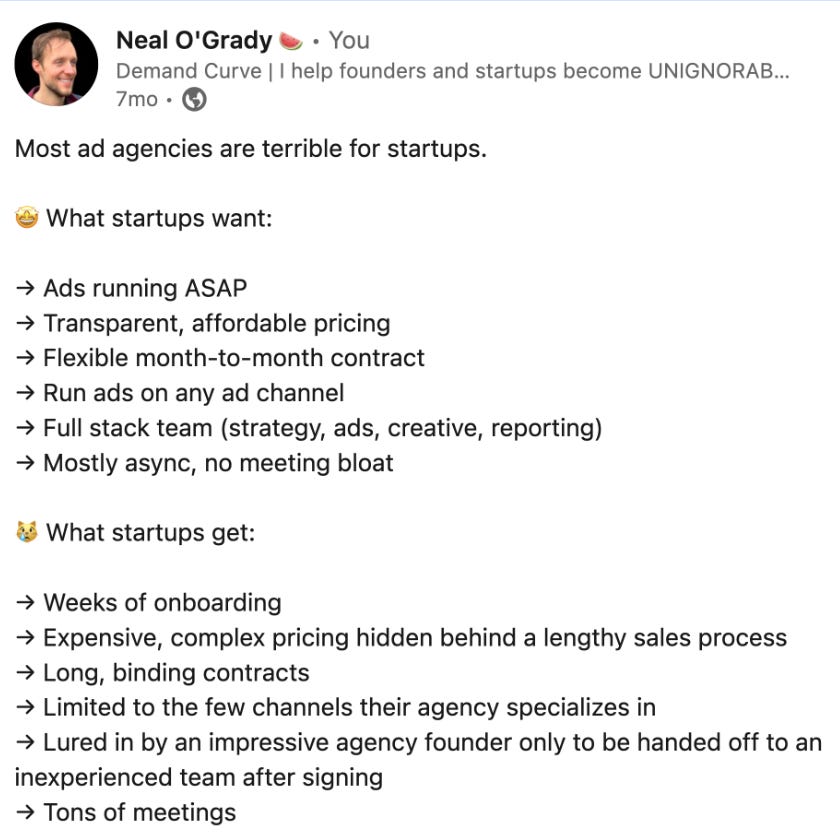
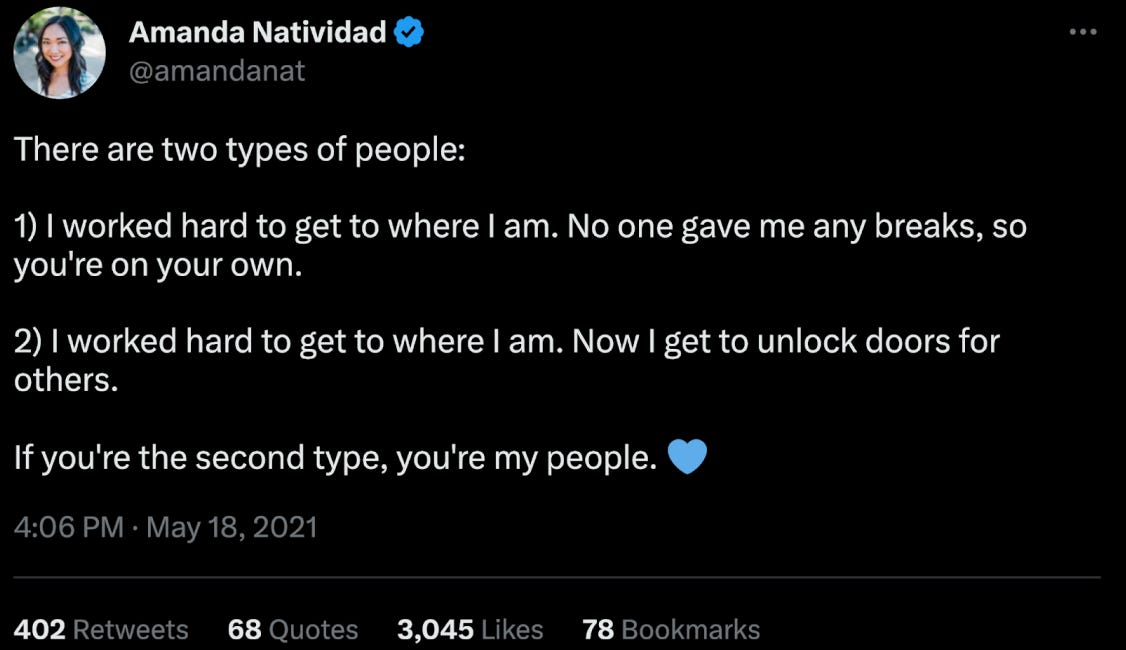
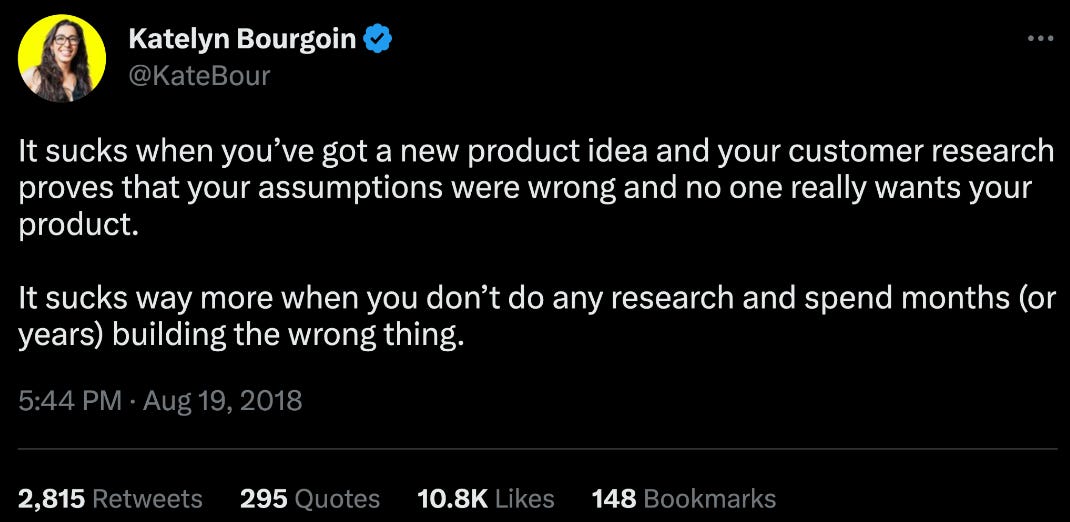
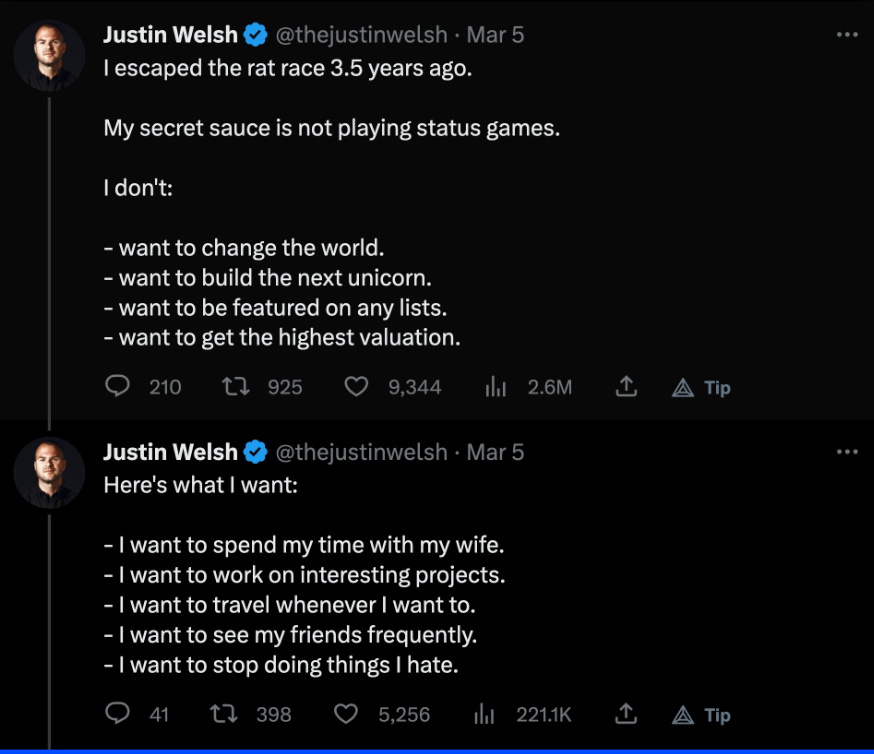
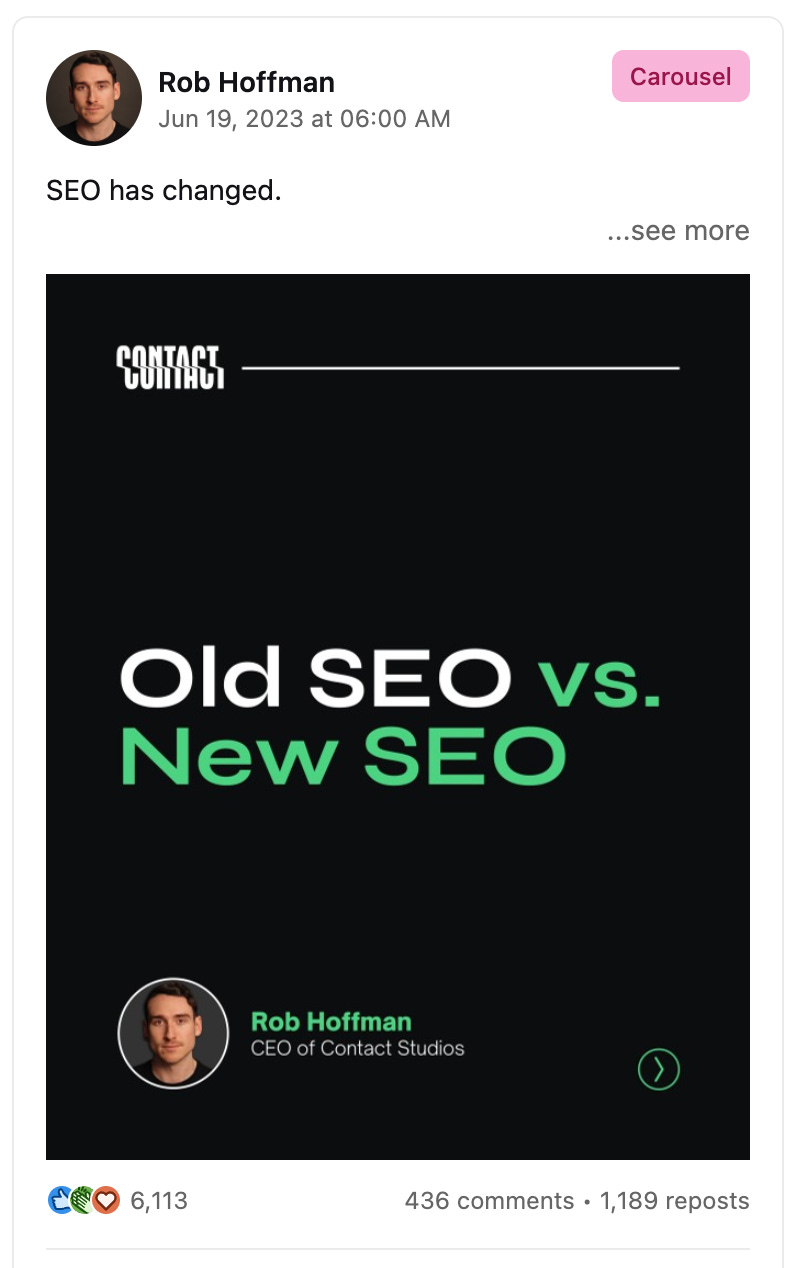
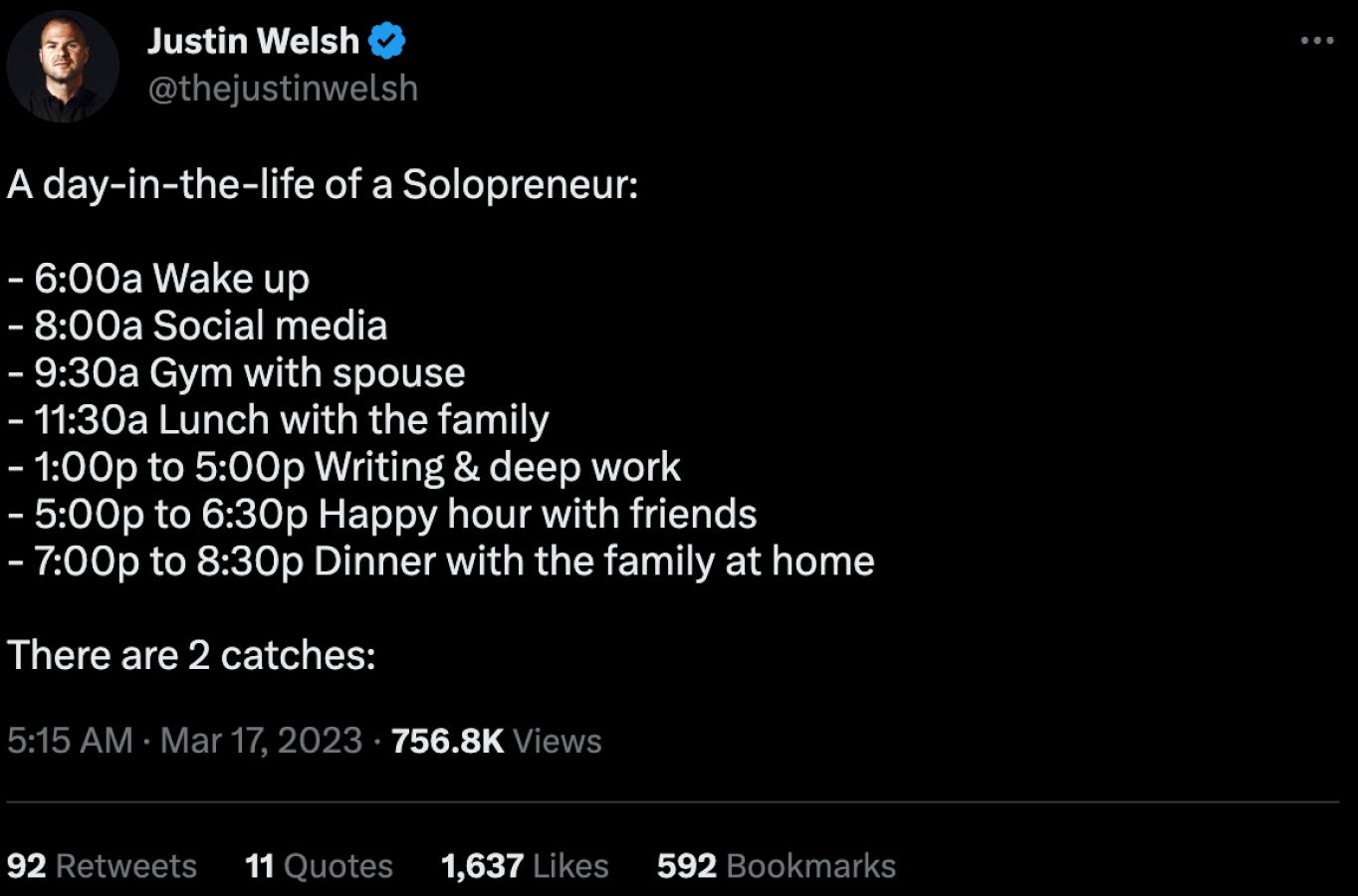
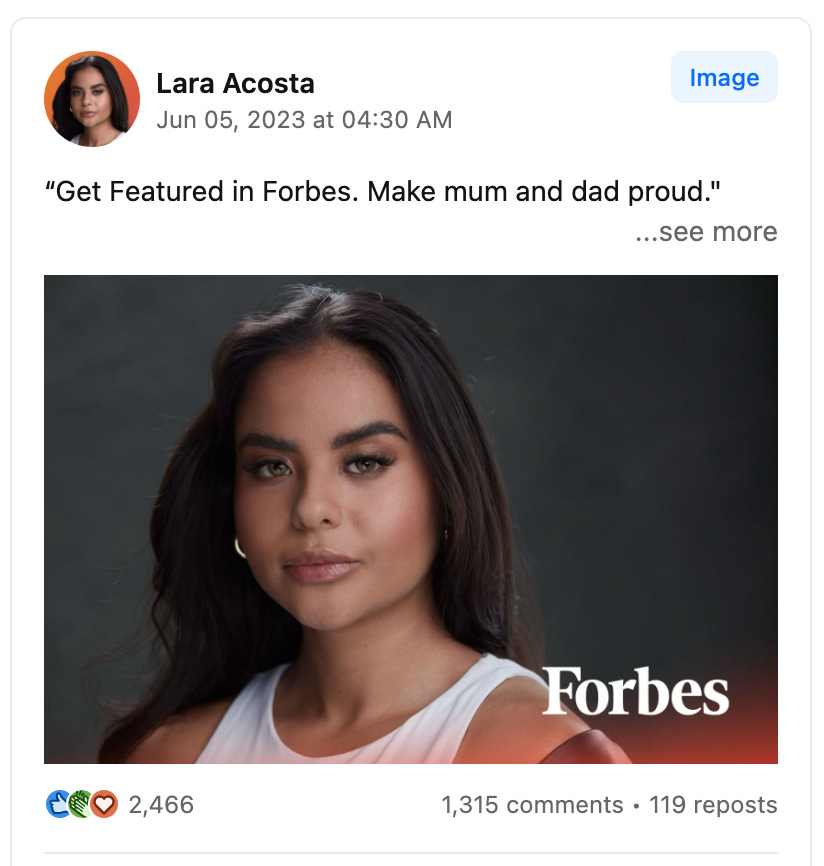
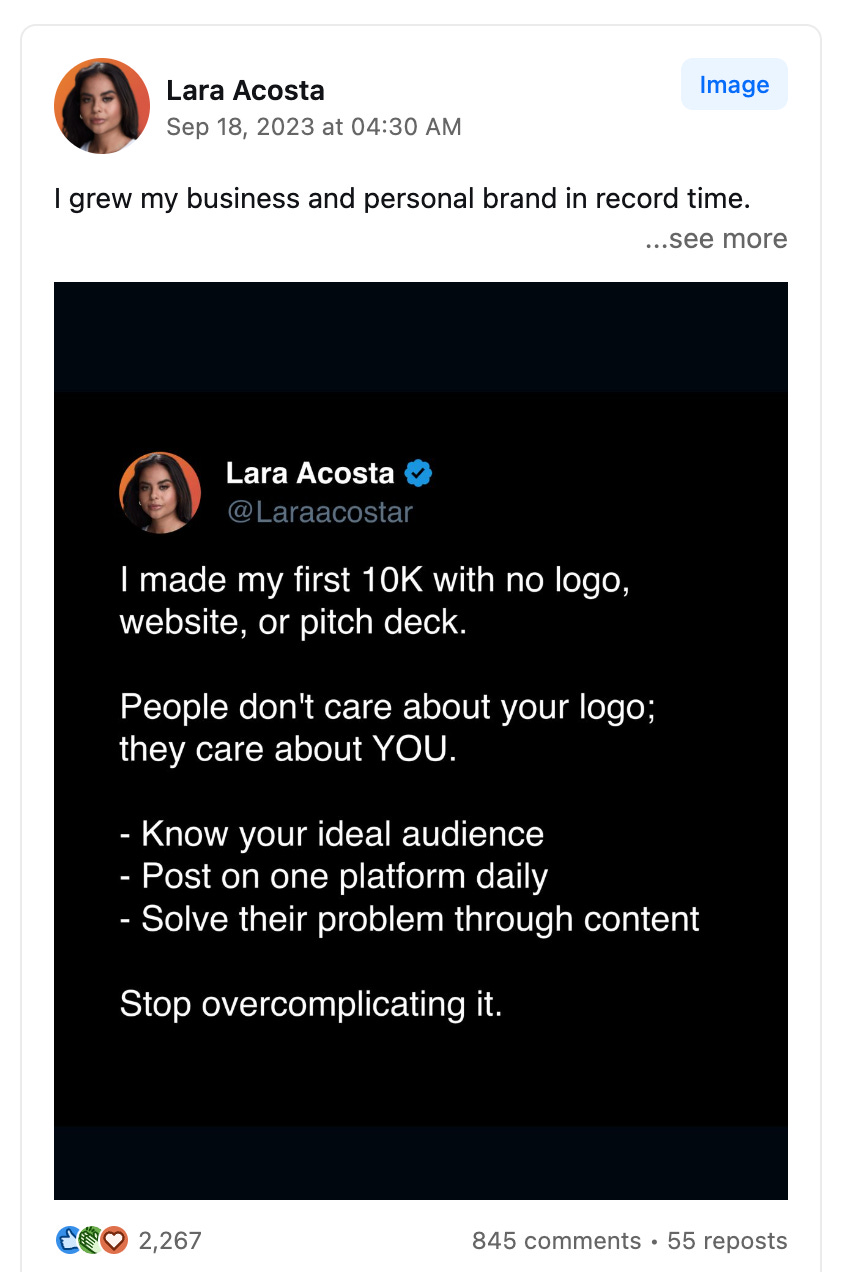
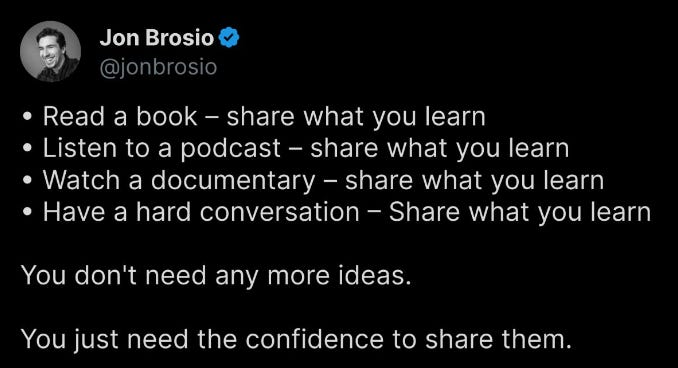
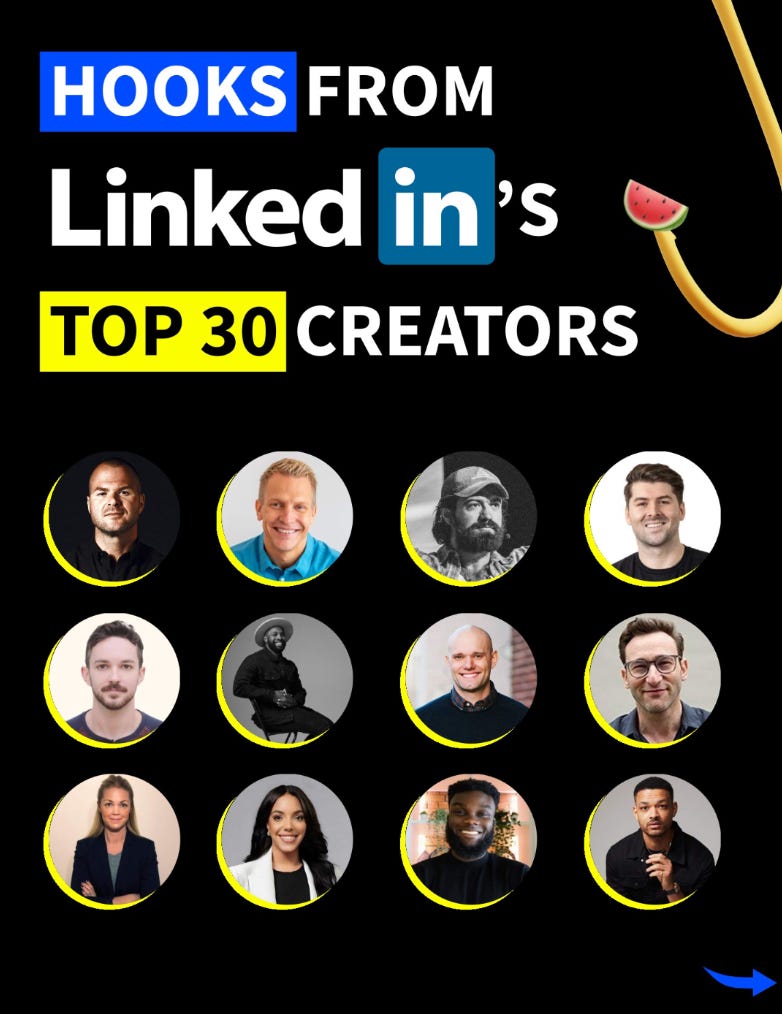
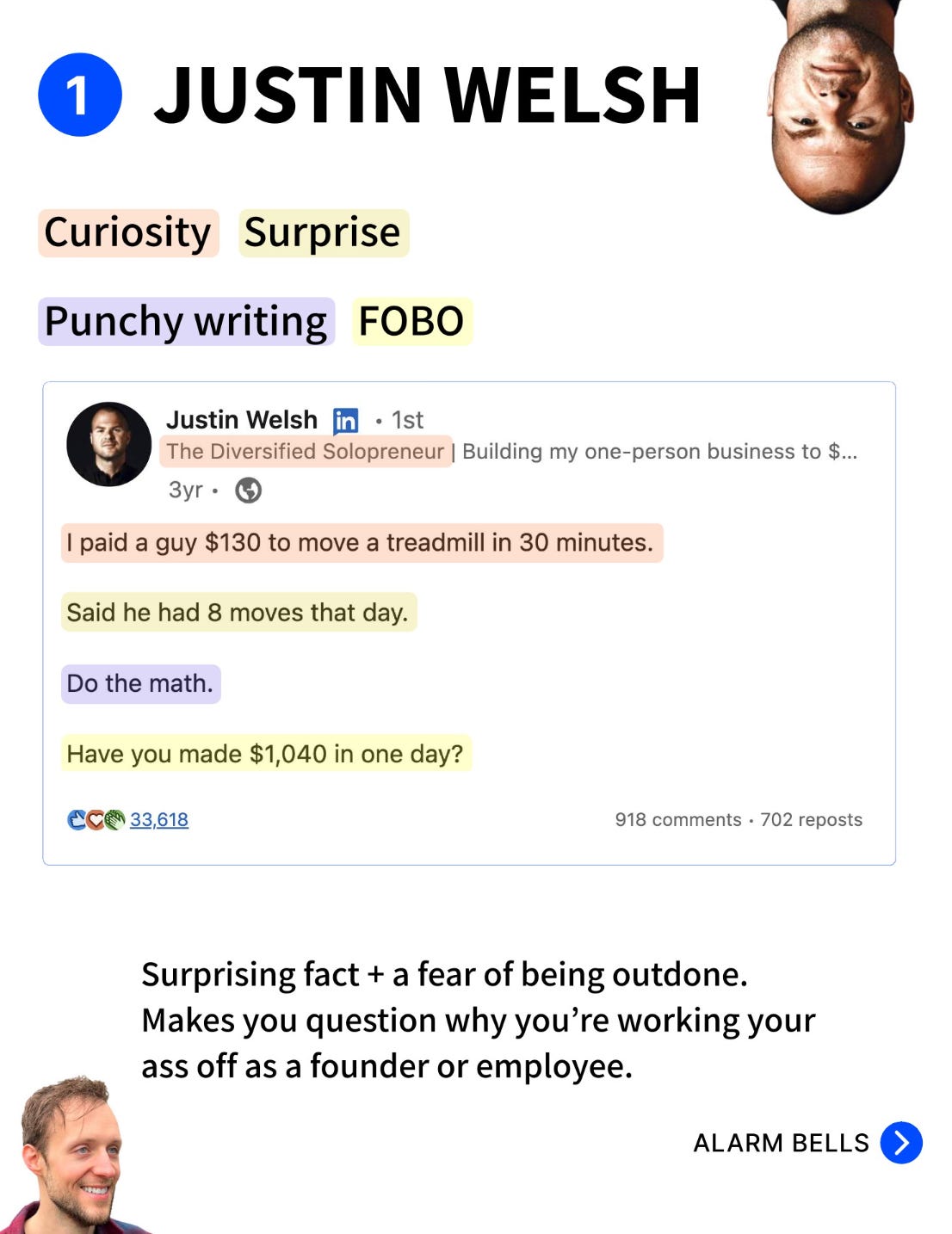
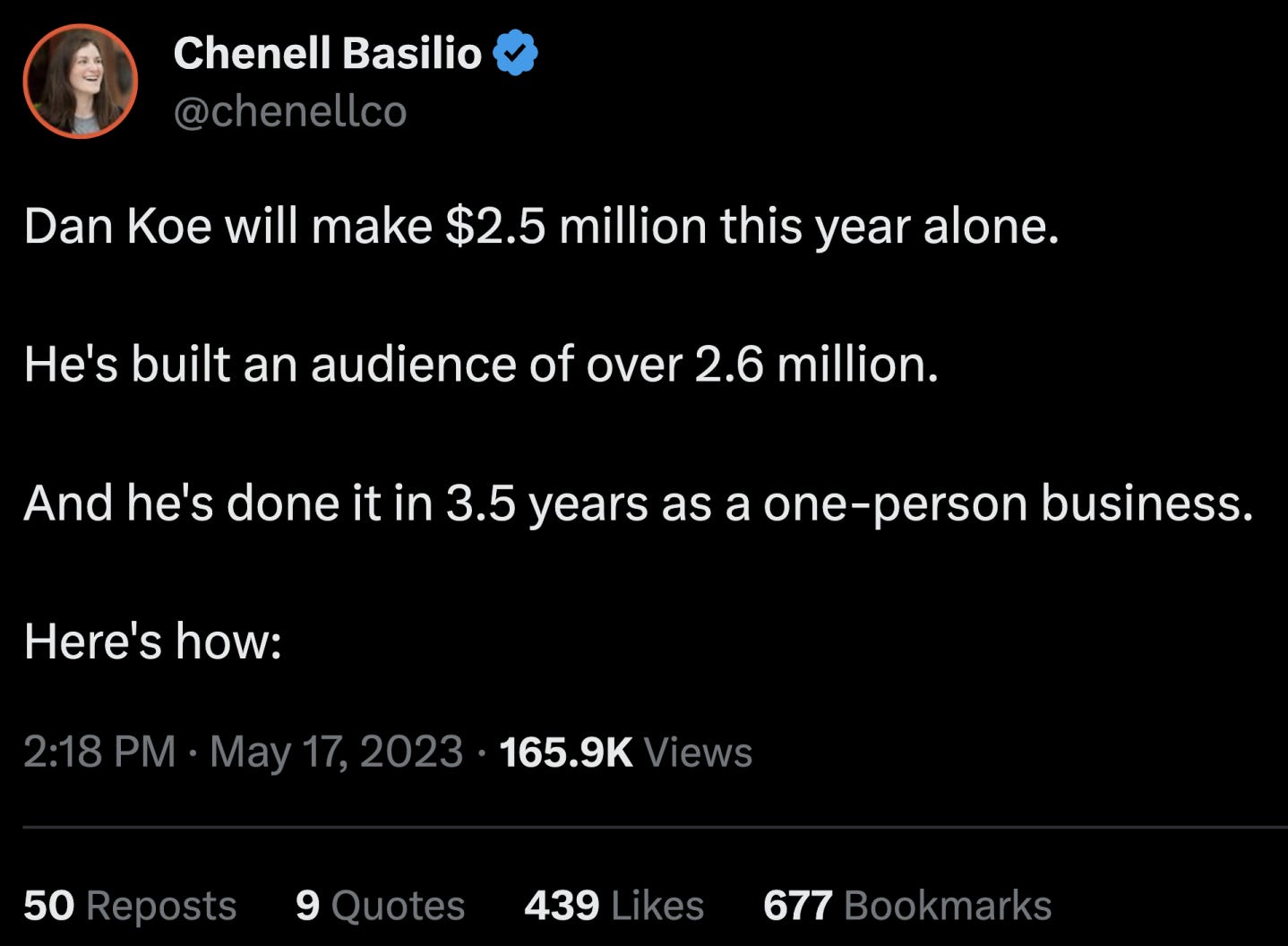
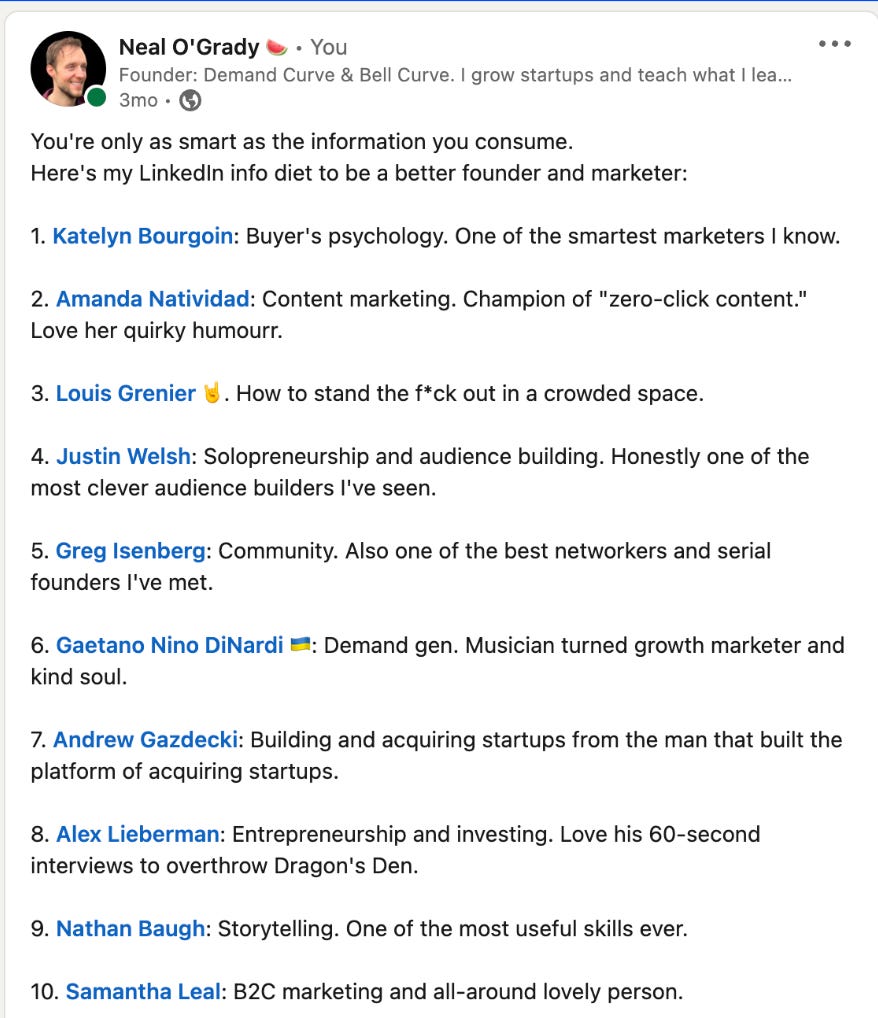
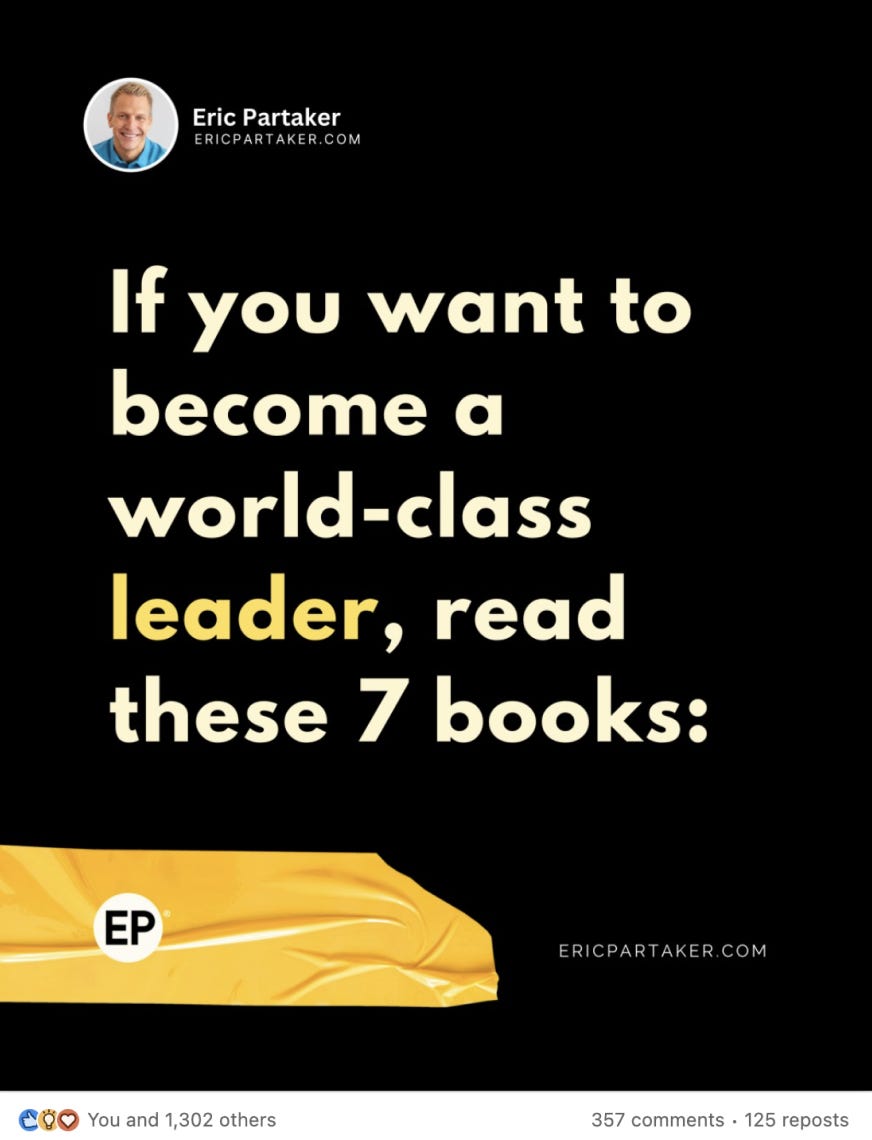



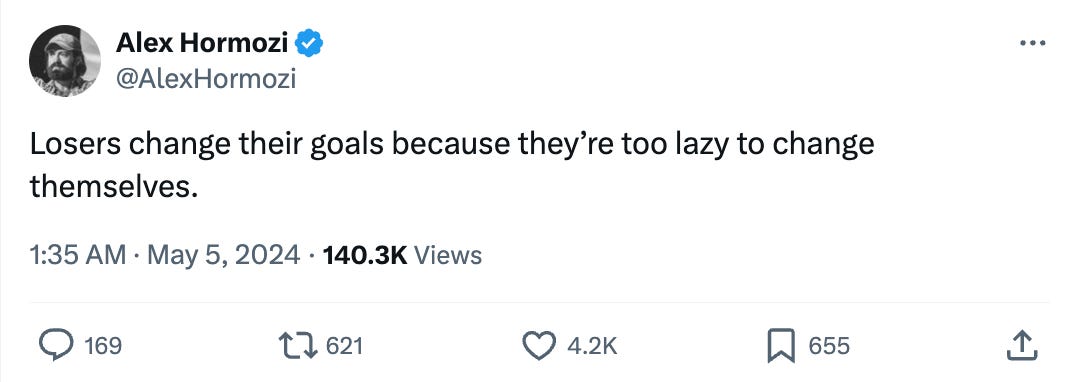
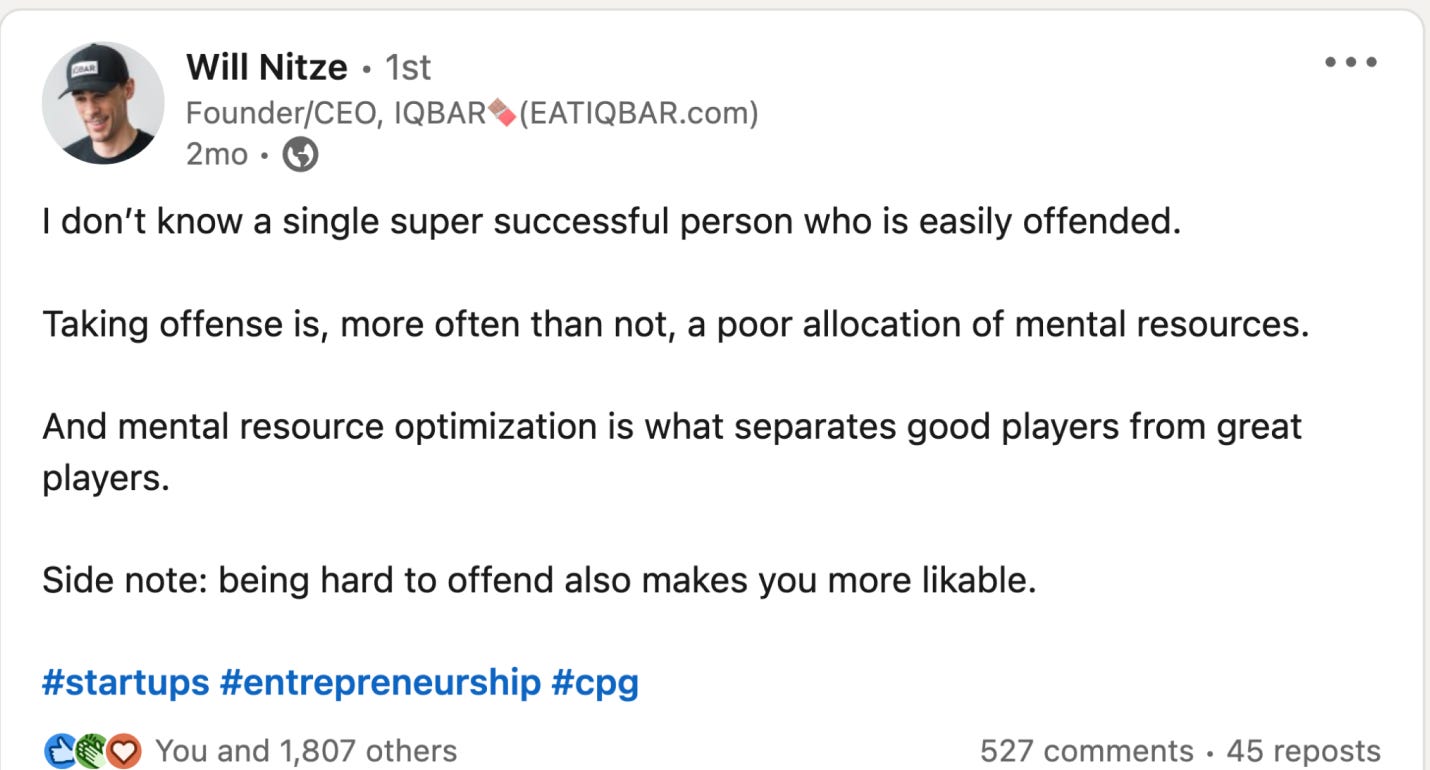
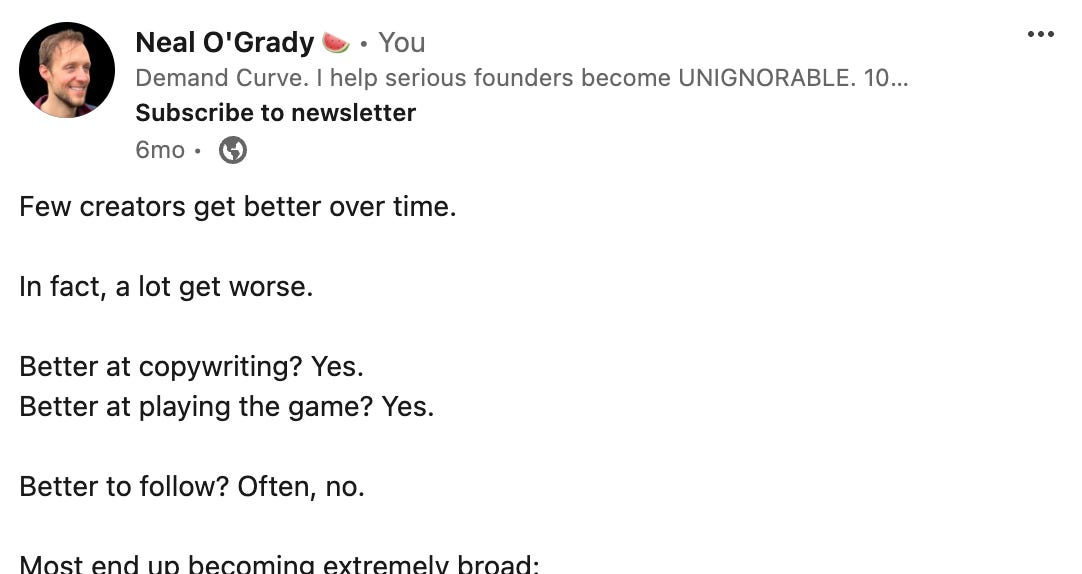
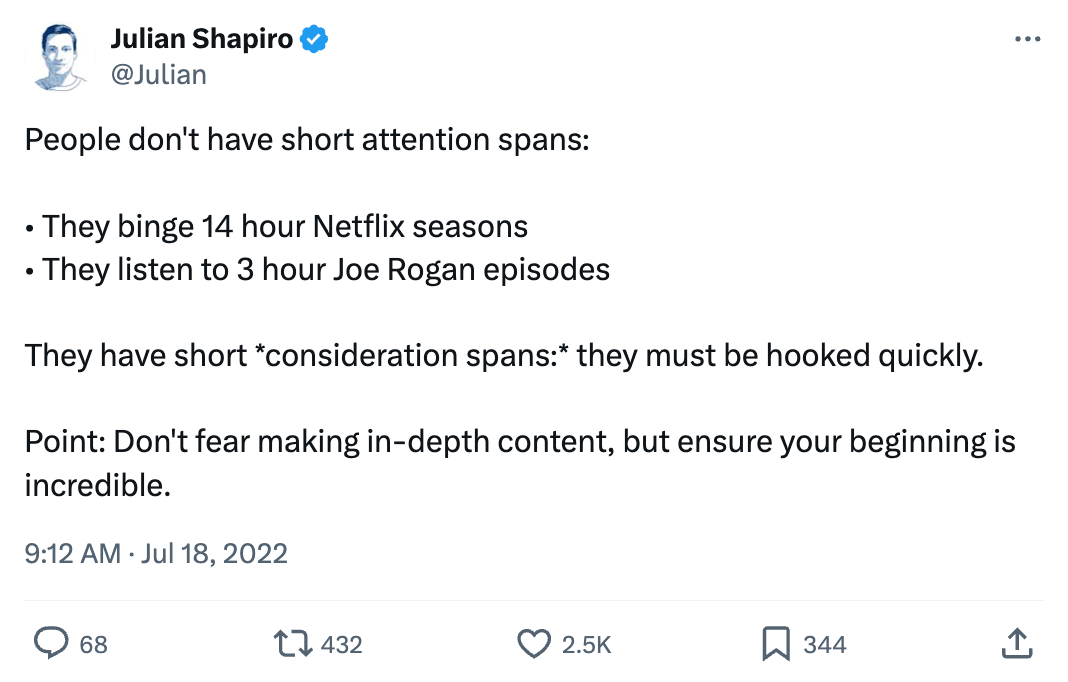
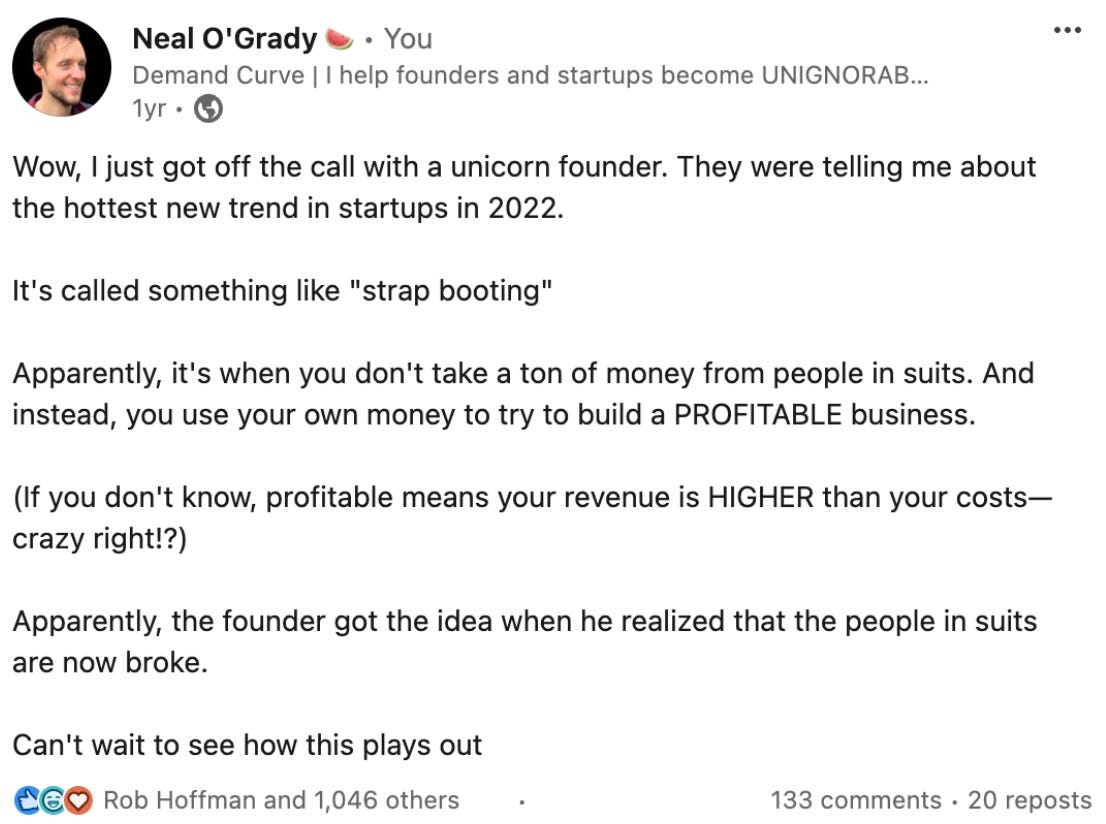
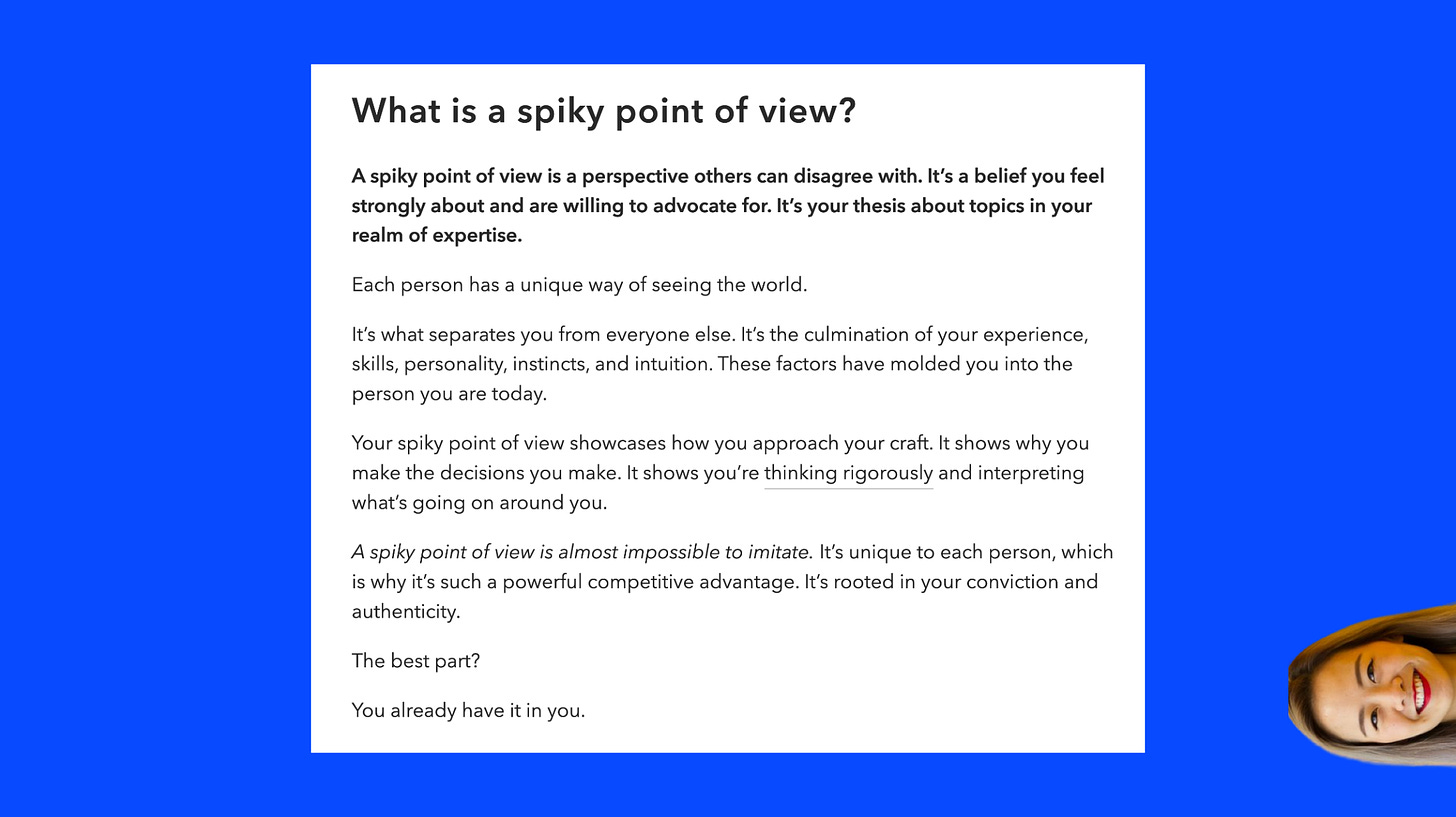
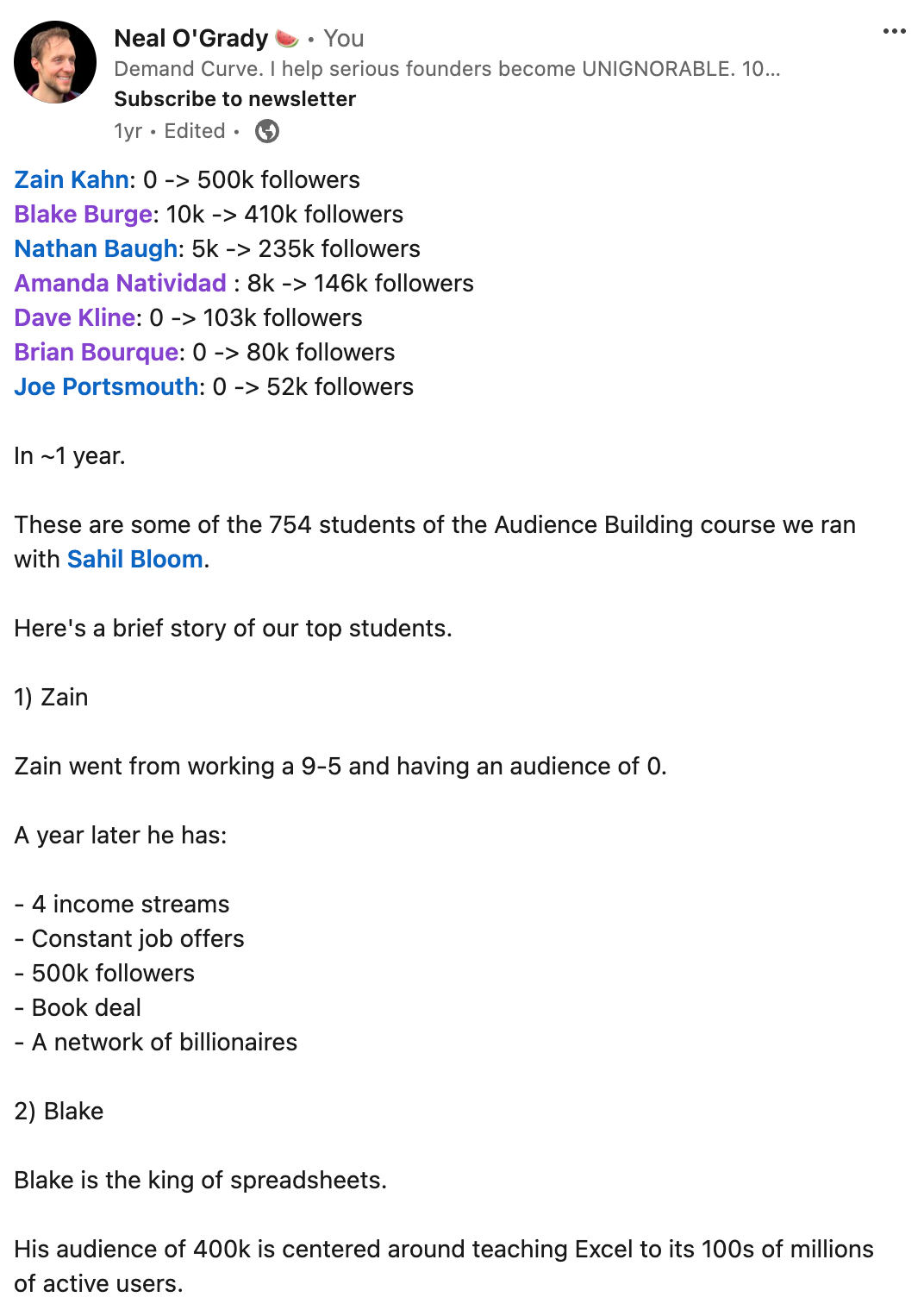
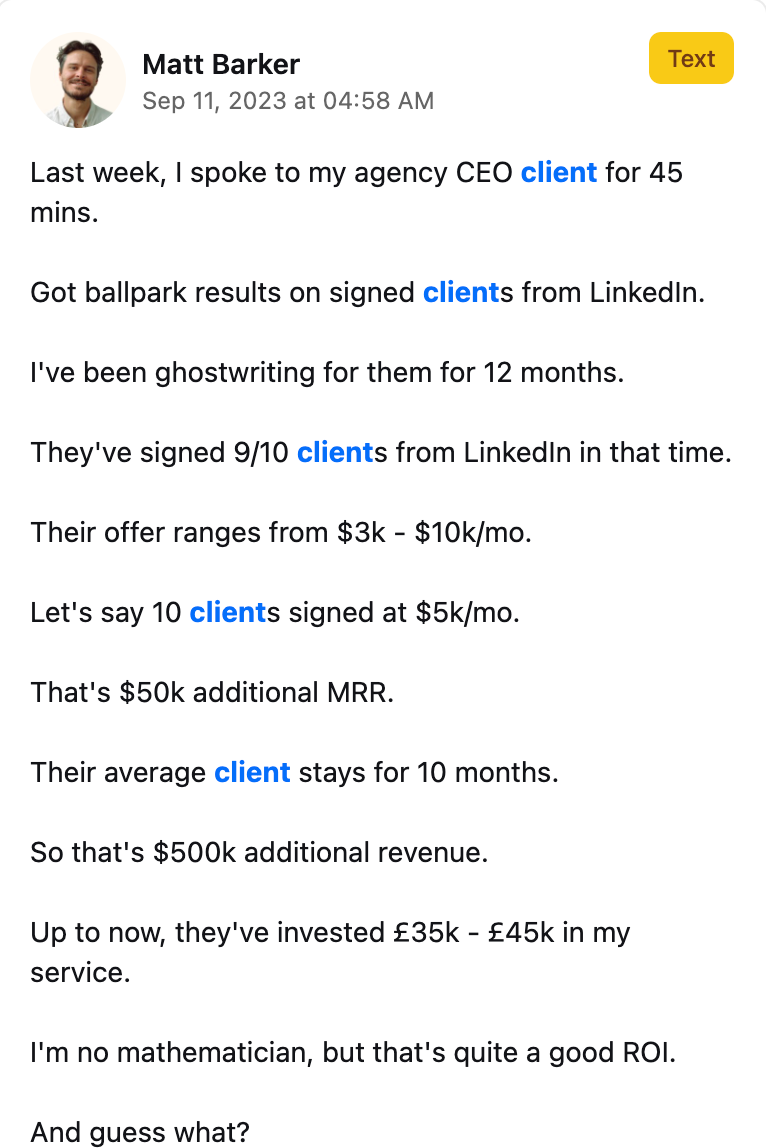
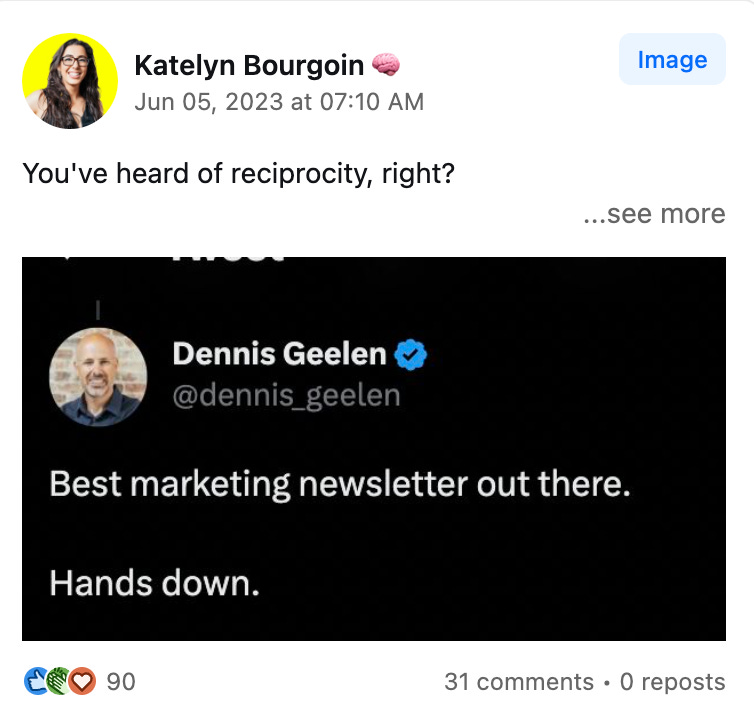
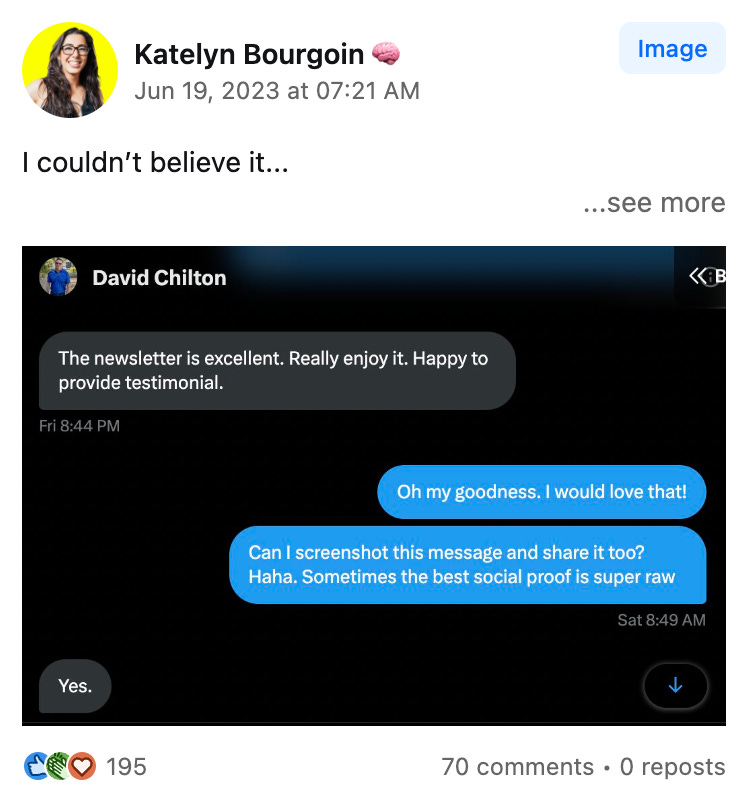
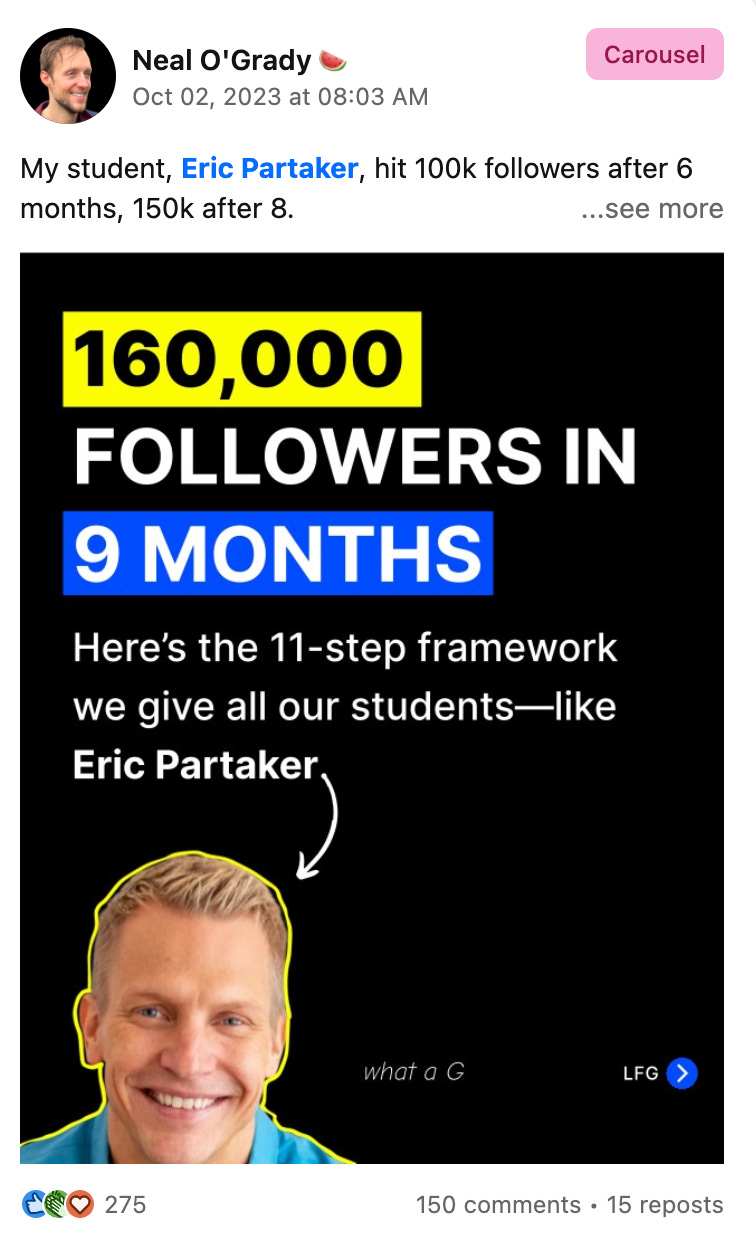
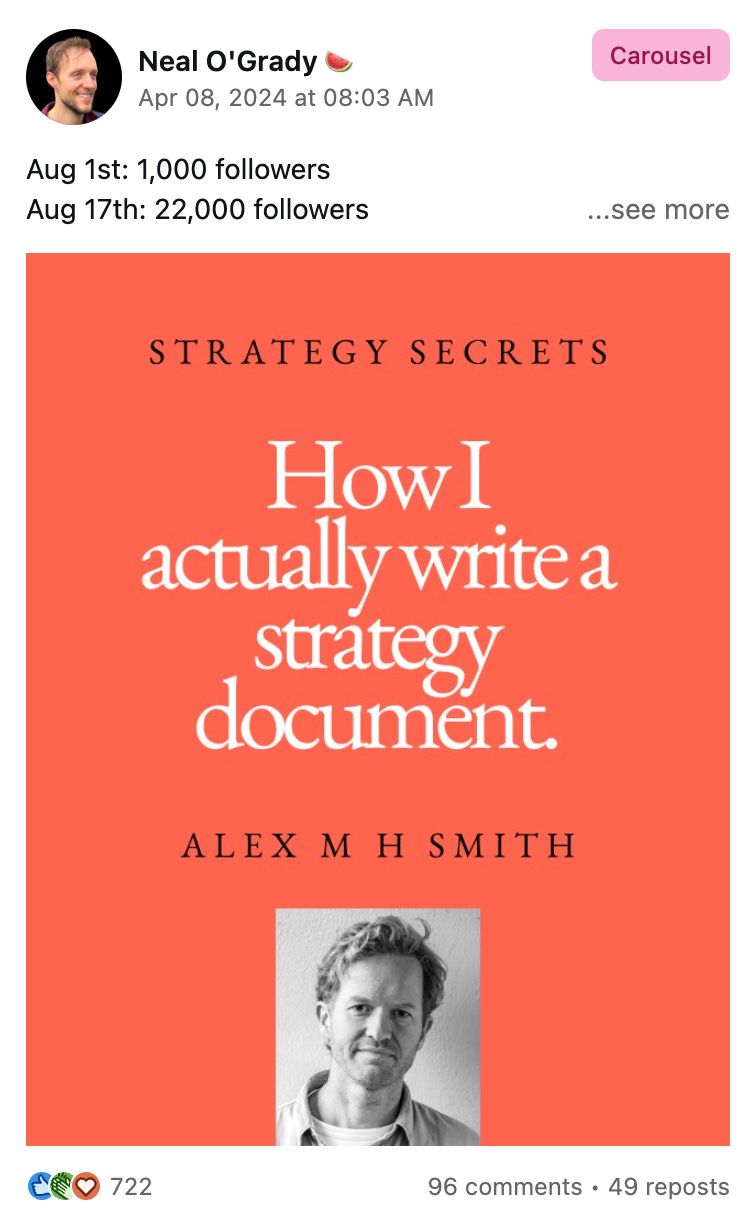
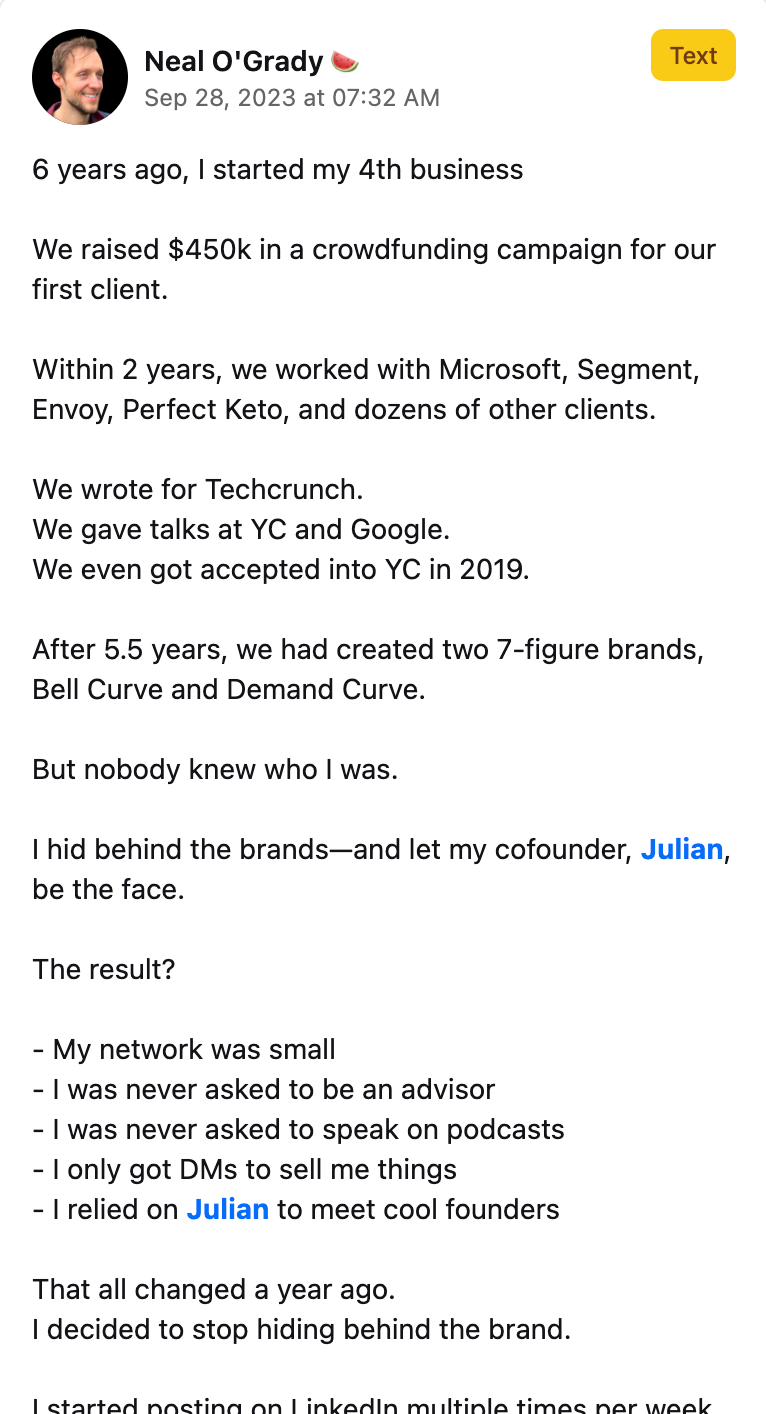
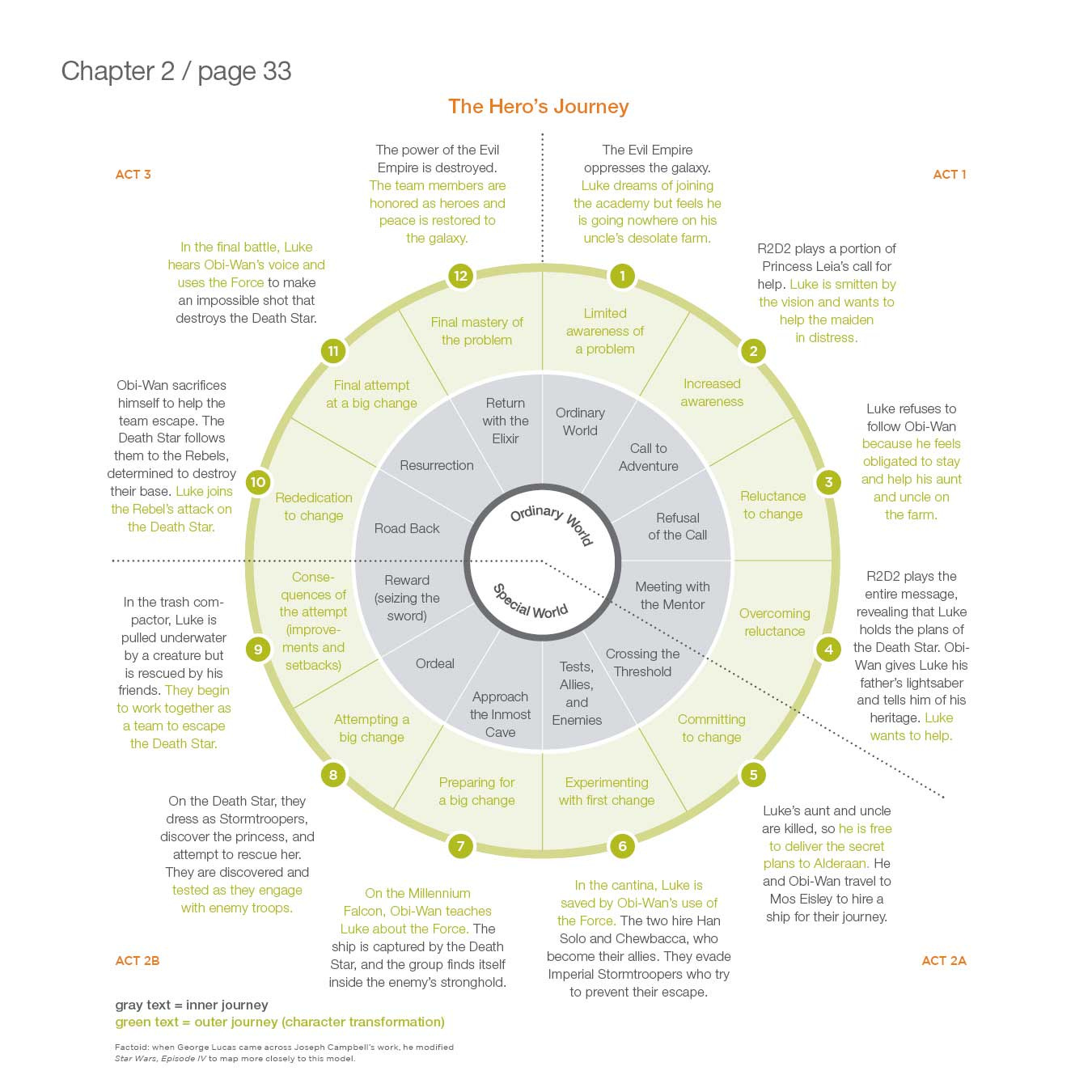

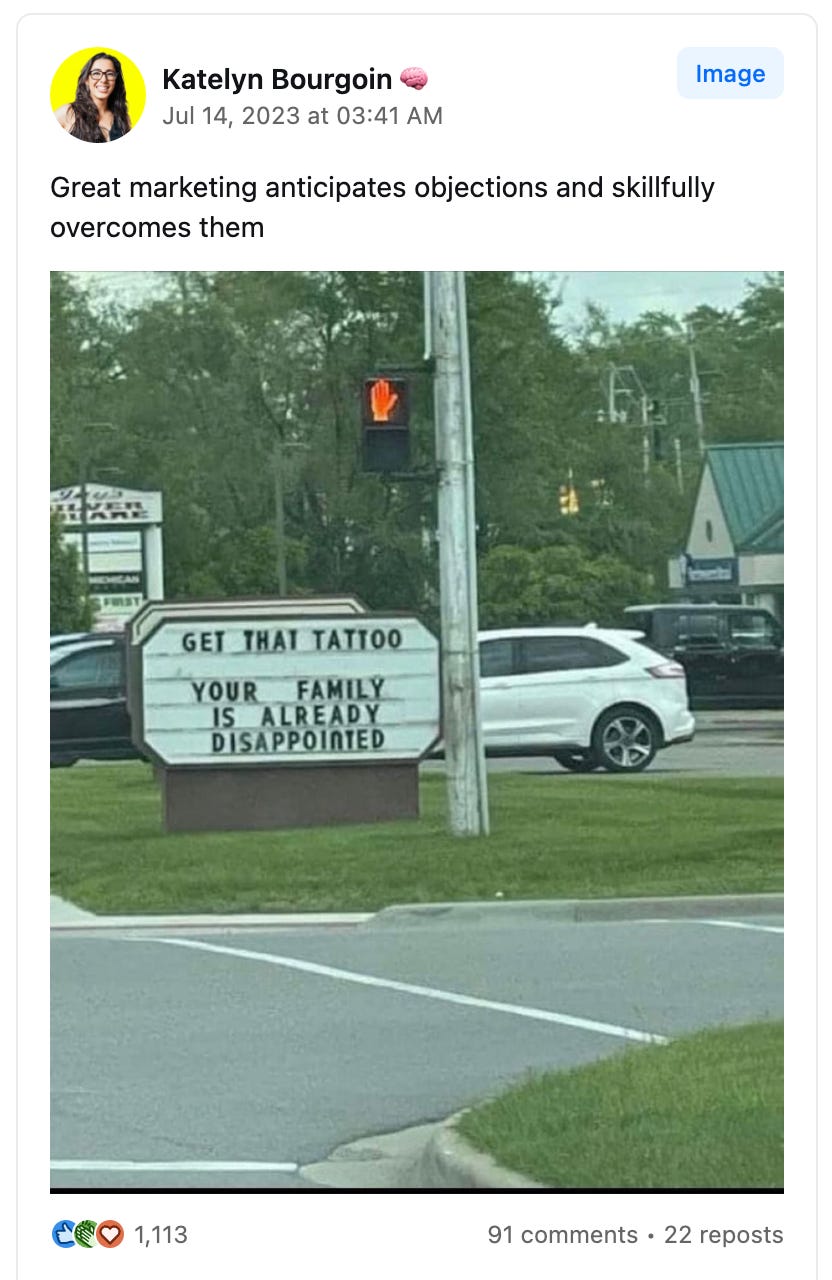
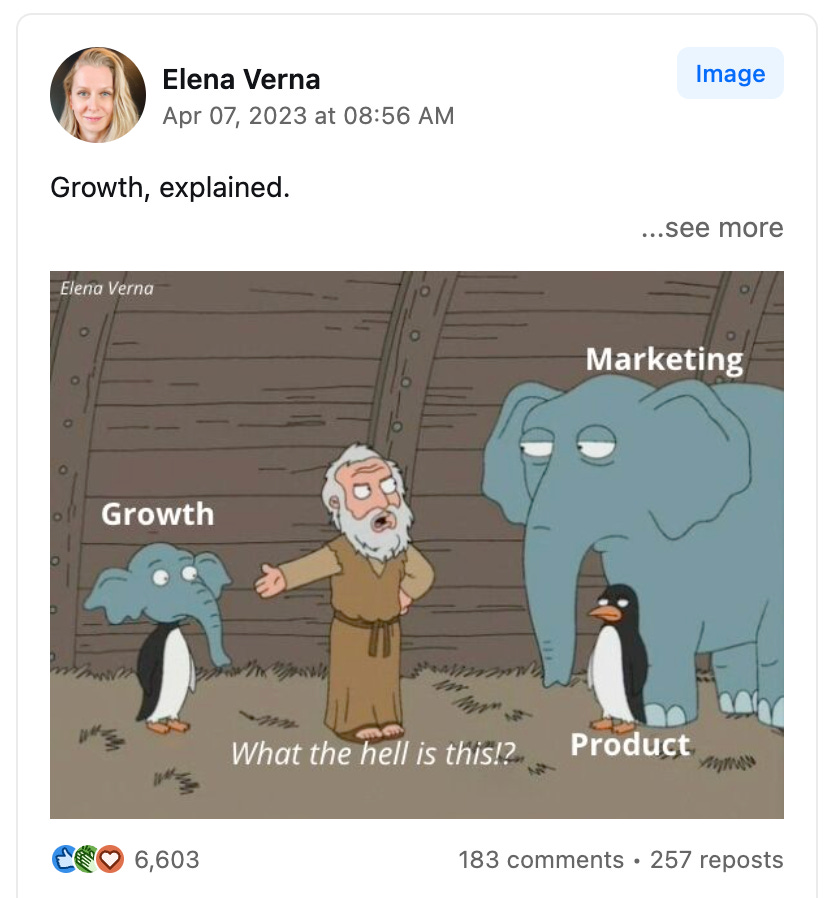
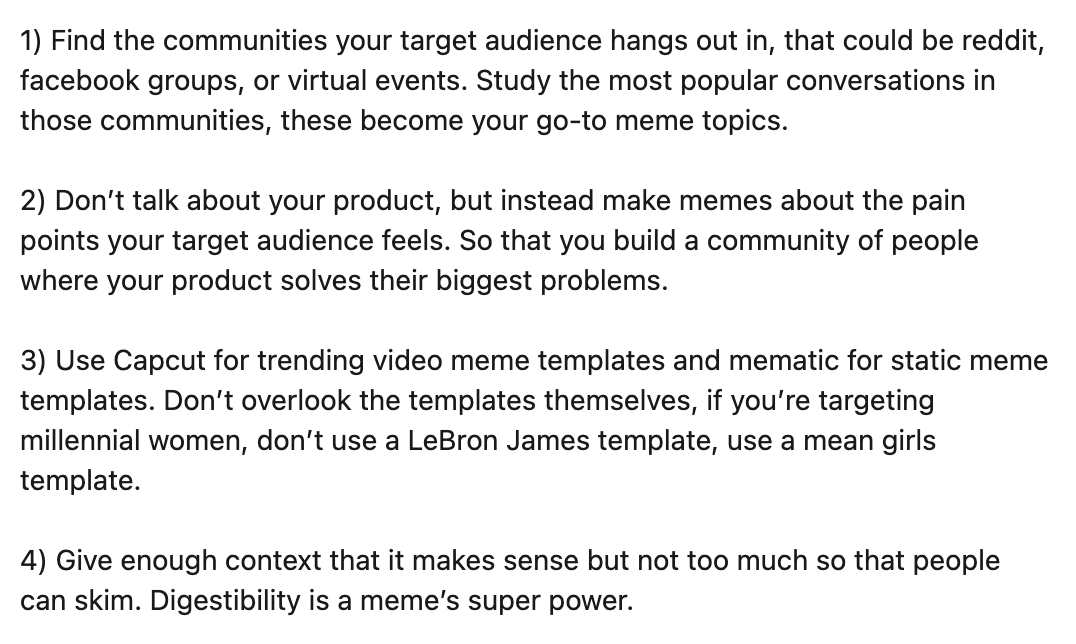
Thanks for the list.